















“Finding your purpose may be the single most important finding of your life,” Manfé said.
Over 400 students, parents and teachers attended TEDxHarkerSchool’s annual event, which featured three guest speakers and startup business booths in the RPAC on Nov. 14.
Each speaker highlighted their experiences in adapting to obstacles and embracing growth, centering their messages around the theme “Metamorphosis.”
MasterChef USA Season 4 winner Luca Manfé opened the speeches with his talk titled “When in Doubt, Toss the Butter.” He shared his journey chasing accomplishment in the culinary industry before discovering that his fulfillment lies with his family.
“Only when I found my real purpose then I was ready to take the journey toward my success. The sooner you understand that the search for your own happiness is more important than the search for success, the sooner you will find both.”
Brand architect Stephen Nilsen followed with “Building Brands from the Street,” discussing the importance of building a personal brand and recounting his experience cultivating canned water company Liquid Death’s marketing strategy from the ground up.
“You’re your own personal brand,” Nilsen said. “All of you
“I was thinking of taking the ceramics course in senior year, and I thought this would be a really good intro to that,” attendee Shaurya Jain (11) said. “I realized that I was trying to push the clay with my fingers, but I couldn’t really get a nice smooth surface, so the club officers taught me to use my whole body, and that went a lot better.”
After completing their pieces, students signed their initials on their pots and placed them on drying racks. Art Club officers will fire and glaze the ceramics, then return the finished products to participants.
Art Club members learned about throwing techniques and made pottery on wheels during lunch on Nov. 12.
Club officers provided one-on-one instruction to participants who were new to wheel throwing, a ceramics clay shaping method. Attendees learned essential techniques at the wheel, like bracing their arms against their body and applying pressure to shape their pieces of clay.
“This is my first time using a pottery wheel,” attendee Aysal Marandian (9) said. “I really learned how to operate a pottery wheel and how to shape it. Even if you don’t have any past art experience, you’re going to learn new things in meetings, and everyone’s nice and inviting.”
Club Events Director Wanruo Wang (10) emphasized the club’s goal.
“We just want our club to just be a place where people can relax and enjoy art,” Wanruo said.
“I think we did that today, so I’m really looking forward to more 3D art events in the future.”
are, so protect that at all costs. Everyday, be a sponge and learn from the experiences around you, and learn to take care of your personal brand.”
“I realize the importance of our small actions and the ways we can still metamorphosize the present.

ANANYA PRADHAN (12) TEDx STUDENT SPEAKER
Student speaker Ananya Pradhan (12) presented “What’s with the Program?” on the
evolution of women in computer science. She encouraged attendees to challenge conventional beliefs to shape a more inclusive future.
“You will have to ask many hard questions in the pursuit of an empathetic future,” Ananya said. “Culturally, there are looming echoes of a society that once excluded women from computer science. But in these small moments, I realize the importance of the small actions we take and the ways we can still metamorphosize the present.”
Prior to the speeches, Harker Incubator students and external businesses held interactive booths, pitching their companies to attendees to gain exposure and receive feedback in the RPAC lobby.
This marked the first year that TEDx opened attendance to parents and students from other Harker campuses.
Junior Cam Krause showcased his non-profit Health Heroes, which aims to provide elementary schools with hands-on health curricula and appreciated the responses from younger students.
“I heard hundreds of people are attending TEDx this year, so we’re able to get massive exposure to all the different Harker people,” Cam said. “We get to show what our businesses are about. It’s a great way, especially for kids, to get beta testing done and get feedback on their products.”
Frosh attendee Ahaana Goel shared her experience interacting with the diverse businesses at TEDx.
“I’m just here to explore, especially because I know business skills are important for the things that I’m interested in,” Ahaana said. “Getting to see everyone connect over these unique businesses was really interesting because a lot of these are ideas that I really wouldn’t have thought about.”
TEDx Curator Mindy Truong (12) reflected on the organization of the event, which has been in the works since last school year.
“I’m incredibly proud of the event this year,” Mindy said. “Our team wanted a well-rounded speaker event that made us think about ourselves both personally and as a society, and I think we really accomplished that. This was the first cross-campus TEDx, so it was amazing to see younger students at the booths engaging with everyone’s businesses.”
Career Connect hosted a Mastering Summer Applications workshop to help students navigate research positions, internships and summer programs on Nov. 10 in the Innovation Center.
Seniors Keira Chang, Mia Tang and Linda Zeng constituted the speaker panel, sharing their experiences finding and applying for summer opportunities. They advised students to take advantage of school clubs, smaller opportunities and independent projects outside of school to demonstrate initiative.
Linda, who participated in COSMOS and the Princeton Lab
Learning Program, reflected on how these programs developed her passion for AI research.
Look for the opportunities that you truly want to pursue and are really curious about.

LINDA ZENG (12) PANEL SPEAKER
“It’s important to not put too much pressure on yourself,” Linda said. “Summer programs are about the experience and
how you learn from that, so look for opportunities that you truly want to pursue and are really curious about.”
Attendees learned about strategies for preparing unique applications through teacher recommendations and guidance from upperclassmen.
Attendee Sophie Wu (10) noted that the tips she learned helped her feel more prepared as she begins applications.
“I learned about starting small, so I can have a base that I can eventually build up on,” Sophie said. “Personally, this makes a difference because before, I was stuck on how to prepare for interviews and form a distinctive application for these competitive programs effectively.”

OBSERVING RESEARCH A group of eighth graders listen to Research Club volunteer Alana Brill (12) explain an experimental science concept. Middle schoolers could attend three different 20-minute sessions hosted by upper school department representatives.
zhu & charlene li
Eighth grade students from Harker experienced a glimpse of high school life the annual Step Up Day on the Saratoga campus on Monday.
The event provided the middle school students with an overview of high school life through sessions. Student volunteers and advisers from groups like Journalism, Business and Entrepreneurship and Robotics helped organize and run the immersive activities.
Eighth graders could choose to attend three activities from 10 options, showcasing the multitude of extracurriculars offered at the upper school.
Attendee Shannon Li gained a new perspective on high school life from attending Step Up Day.
“After going through these different experiences, I realized
that high school is more than just classes and homework and tests,” Shannon said. “We should not worry about the future and the college we’re going to. We should just be in the moment, make new friends, families and relationships — relationships really matter, and we should cherish that.”
ASB President Luke Wu (12) and ASB Spirit Coordinator Albert Yao (12) opened the event, discussing the transition from middle to high school and introducing spirit events. Harker Spirit Leadership Team (HSLT) volunteers then guided eighth graders through a mini spirit rally.
“I got to tour kids around campus and introduce Spirit to the Class of 2030,” HSLT committee member Patricia Li (10) said. “We held a scream-off for them, which was really fun because we got to help them understand how we do spirit
charlie wang & aileen jang
Student Diversity Coalition (SDC) hosted their first ever Lunch and Learn on Nov. 10, where students gathered over lunch to explore questions regarding DEI.
Senior SDC officer Elie Ahluwalia, who proposed the initiative, hopes SDC can help foster a space where students can talk about important social issues and promote open, respectful dialogue among fellow students.
“I’ve always wanted to do lunchtime talks at Harker, specifically with DEI focus, ever since I ran in sophomore year,” Elie said. “I wanted to create Lunch and Learn because people can come if they don’t have anything to do. In our political climate, there are a lot of topics that students do want to talk about with other students, but it’s not as
comfortable to talk about those things in the classroom.”
Elie and SDC officer Arushi Sahasi (12) guided the group through a set of discussion questions designed to encourage thoughtful conversation. The prompts ranged from DEI policies to students’ experiences with inclusion on campus.
“
In our political climate, there are a lot of topics that students do want to talk about with other students.
ELIE AHLUWALIA SENIOR SDC OFFICER
here at the high school, since they don’t have rallies like this at the middle school.”
“Going through these different experiences, I realized that high school is more than just classes, homework and tests.

LI
Seniors Henry Fradin, Christy Ma, Daniel Miao and Ananya Pradhan spoke in a panel session to close the evening. They answered questions from students and parents, sharing insights about balancing academics, extracurriculars and social life at the upper school.
“Try things, because you might think you have this preconceived vision of who you’re going to be,” Daniel said. “But in your time in high school, it’s really fun to challenge that vision and see, ‘Hey, I could actually do this. I could actually do that,’ and just really exploring yourself through these activities.”
Head of Upper School Paul Barsky shared the high school’s educational philosophy he aims to foster in the eighth graders.
“I hope to see kids who are exploring areas of themselves,” Barsky said. “This is a place where they can develop the fullness of their own humanity and tell the story of themselves, which is so important as teenagers. In the upper school, we want students to be curious about what they may discover. Students will have opportunities to follow their own educational journey, unlike anybody else’s.”

of the benefits and the challenges surrounding these issues on campus and beyond.
“I went because I wanted to learn more about DEI, how it looks in America right now and how it’s being impacted by the current political climate,” Marc said. “It was intersting and also helped me understand what SDC actually does.”
At the end of the meeting, Director of Diversity, Equity and Inclusion Patricia
Students hustle for muscle dystrophy awarness
lily shi & eva cheng
Harker DECA hosted their “Hustle 4 Muscle” volleyball tournament between grades to raise awareness for the Muscle Dystrophy Association on Nov. 12 and Nov. 14 in the Athletic Center.
Teams competed in short-format games, with seniors narrowly defeating sophomores 19-17 and juniors winning comfortably over frosh in first-to-15 matches on Wednesday. The winners advanced to the final round, where the juniors swept the seniors 2-0 in a best-of-three series to 11 points on Nov. 14.
MDA, a longtime DECA partner, funds research for neuromuscular diseases and provides support for those living with muscular dystrophy, a genetic disease that causes progressive muscle weakness. Harker DECA has supported the organization during DECA month with annual volleyball tournaments for years.
While Harker DECA cannot directly fundraise as a chapter, officers encouraged students to donate to MDA by speaking about MDA’s work before games and displaying a slideshow with information.
“Even if people don’t decide to donate, it gives them an idea of what MDA is and what the association does,” DECA Director of Communications Sofe Jalil (10) said. “It raises awareness and raises funds for people in need.”
Sofe noted the strong participation this year, with seven signups from the Class of 2029, 10 from 2028, seven from 2027 and six from 2026.
Burrows invited students to SDC’s next Lunch and Learn, where attendees will discuss affirmative action.
“Some deeper conversation would be helpful,” Burrows said. “If someone has attended the Harker School for all of their life, they may not be aware of how other schools operate and the different issues that come up when it comes to resources and access to information or opportunity.”
“At first the signups were a little empty, but it turned out every grade had a sufficient amount of players,” Sofe said. “Everyone heard the talk about MDA and what the cause is about, and there’s a lot of people watching, so the turnout is much better than I expected.”
Substitute teacher Derek Lau appreciated the opportunity to watch the event both for the cause and for the competition.
“I’ve played volleyball recreationally on the side,” Lau said. “I heard volleyball and I thought it would be kind of cool just to check it out. It’s a good team sport, a lot of good coordination is needed.”

Mamdani wins New York City mayor race
34-year-old state assembly member Zohran Mamdani won the New York City mayoral race on Nov. 4, defeating former Governor Andrew Cuomo and Republican Curtis Sliwa. His campaign centered around promising less expensive housing costs and free public transit, drawing strong support among progressive voters.
Sudan North Darfur crisis threatens decline
Recent Security challenges, depleted supplies and restricted access across North Darfur make aid efforts in Sudan at risk of complete failure. Tens of thousands of Sudanese are displaced, with overcrowded camps rampant in starvation, leaving over a third of children under five facing severe acute malnutrition. Since April 2023, Sudan has struggled with internal conflicts as fighting between the Sudanese Armed Forces and the Rapid Support Forces continues across the country.
G7 ministers attend meeting in Canada
High-ranking foreign ministers from seven of the world’s major industrialized democracies met in Ontario, Canada on Nov. 11, to coordinate on global security issues, Middle East mediation efforts and Russia-Ukraine war relief. The talks also centered on securing critical minerals and energy needed for key technologies, ranging from phones to fighter jets.
China’s car industry sales stagnate
Several local Chinese governments have discontinued the eligibility of trade-in incentives in certain regions, resulting in a decrease in purchases for both electric and gasoline cars. In response to the waning domestic demand, BYD, the leading global manufacturer of new energy vehicles, has ramped up its plans for overseas expansion. Consequently, Tesla’s sales in the area dropped 36% and BYD’s overall sales fell 12%.
Power outage across Dominican Republic
Generation unit failures in San Pedro de Macorís and the Quisqueya Power Plant caused a widespread blackout on Nov. 11, which derailed mass transit, businesses and daily activities for 11 million residents. As of Nov. 12, all generation power plants are back online, and the national grid is back to full capacity, powering power to about 96% of the country.

California voters passed Proposition 50, marking a Democrat triumph among other sweeping victories for the party as Election Day 2025 concluded on Nov. 4.
Prop 50 passed in a landslide with 64% support from 43.2% statewide turnout and 39.2% voter turnout in Santa Clara County. The proposition authorizes California to redraw the congressional map to favor Democrats until 2030, aiming to flip up to five congressional seats in the U.S. House of Representatives.
“I expected it because California is a democratic state, so a lot of people are going to be in favor of strengthening that power,” senior Amishi Gupta said. “A lot of people, generally in the Bay Area and Los Angeles, do prefer the proposition because it gives more seats to the Democratic side.”
History teacher Bronwen Callahan observed that in a left-
leaning state like California, political bias can influence the perceived benefits of the legislation that is proposed.
“People voting for Prop 50 overwhelmingly show that they do believe this redistricting will happen in a way that is fair,” Callahan said. “However, you would have to look and see as to how many people voted for this because they had full faith in the redistricting process and how many voted for this because they heard it was gerrymandering and wanted that to happen.”
Democrats also garnered wins with local measures, including the passing of the temporary five-eighths sales tax on the Santa Clara County ballot. In response to federal cuts to Medicare, the policy raises sales tax by five-eighths of a cent (0.625% increase) for the coming five years to fund local healthcare services and is estimated to generate $330 million annually.
“Someone has to pay for taxes, someone has to pay for Medicaid, and someone is going
to benefit from Medicaid and sometimes that’s all in one,” history department chair Mark Janda said. “Everyone has to buy things, and those who can
afford the least can least afford to have their sales tax increased. At the same time, those very same people are most likely the beneficiaries of more money available for Medicaid. These are double-edged swords.”
The Santa Cruz County Workforce Affordability Act, Measure C on the Santa Cruz ballot, imposes a parcel of $96 and graduated real-estate transfer tax funds, with a 0.5% rate on properties worth more than $1.8 million and 2% for those in excess of $4 million to fund an affordable housing development program.
Across the country, the results of the Nov. 4 election signaled the occurence of a broader political shift.
The impact of Prop 50 extends beyond California, aligning with a wider movement among Democratic-leaning states to counter the Trump administration’s recent policies and expand the representation of Democrats.


The longest federal government shutdown in U.S. history concluded on Nov. 12 after 43 days.
The shutdown began on Oct. 1, after lawmakers failed to agree on a federal budget for the new fiscal year, leaving many government agencies unfunded.
Hundreds of thousands of federal workers were laid off or required to work without pay, key services slowed and agencies kept only their most essential functions running.
Now that the government has reopened, agencies are gradually resuming regular operations, but the shutdown’s length and national visibility have raised concerns about political polarization and public trust.
Anirudh Subramanian (11) discussed the political strategy behind appropriation bills.
“Different political parties have tried to use the bill to further their agenda, especially

the party in power,” Anirudh said. “They’re trying to include things in the bill to get passed because the appropriations bill must get passed inevitably.”
History and social science teacher Chuck Witschorik also connected the length of the shutdown to the wider political climate.

“We know that algorithms and the way that social media are run tend to magnify extreme views, because those views tend to garner more clicks,” Dr. Witschorik said. “In this case, with Congress, politics or with partisanship, the more extreme right or extreme left voices tend to be more strident.”
Civil Discourse Club President
emphasized that the shutdown affects lowincome communities most.
“The funding that had ordinarily come from the federal government to help support members of the disadvantaged communities was often just not there,” Timothy said.

leah krupnik & shreyas karnam
It was a normal morning at KION, the Central-Coast based news channel. An editorial meeting had just ended. Then the station’s reporters — all 13 of them — were informed that they had been laid off.
KION’s shuttering is not an isolated trend. According to an October report from Northwestern University, more than 2,000 U.S. local newspapers have closed over the past 25 years, and many more have been acquired by national corporations.
Journalism teacher and yearbook adviser Stephen Baxter co-founded and ran the Santa Cruz Local before coming to teach at Harker. He explained that one of their major benefits of local publications is their ability to narrow the aperture of national politics to local communities, as well as improving civic
accountability and engagement. Baxter emphasized the problems that these so-called “news deserts” face.
“There are places in California that now no longer have a daily newspaper, or they don’t have a local TV station,” Baxter said. “So many people rely on rumors and informal networks. Some of that stuff is really useful, but not professionally produced, and so it’s not necessarily fact-checked and not necessarily reliable. There are still so many news deserts, which is really a shame.”
At Harker, the student journalism program strives to keep students informed about local, national and international news. Student journalist and Winged Post Editor-in-Chief Ashley Mo (12) expressed concern over not knowing the reliability of information
“The national trend is that print and local journalism are on the decline, especially among youth because of social media,” Ashley said. “The biggest problem with that is misinformation. Social media can skew news one way or the other, so having reliable print journalism is really important, because we put in the effort to be unbiased as much as we can.”
However, recent polls conducted by the Pew Research Center show that 45% of teens believe journalism does more harm than good to democracy. With trust at a low, many turn away from it altogether. 84% of teens say they distrust the media, and the majority of teens turn to social media for news instead.
Some students, like sophomore Anusha Saha, enjoy keeping up with the school and professional news. Anusha
“Having online journalism makes news accessible,” she said. “A lot of news stations now have online apps or websites, so you don’t have to have a newspaper in your hands. You don’t have to have a TV in front of you. How many people are getting physical newspapers these days for anything except the Sunday crossword?”
Harker provides its students with digital access to the New York Times, which 81.6% of survey respondents said they used regularly. Librarian Amy Pelman emphasized that giving students reliable local journalism is integral to the library’s mission.
“One of the library’s core missions is to connect its constituents with access to information and news,” Pelman said. “Providing that access is always an important thing that the library can do for the community. Lots of people stop at the New York Times and don’t look at local journalism as much, but we actually have multiple newspaper databases. You have to be a little more determined to actually read a local paper, but it’s all here.”

As the library works to publicize these resources, journalists are adapting their content to fit the digital landscape and meet readers where they are. According to Ashley, Harker Aquila, Harker’s student news site, has moved into more interactive and multimedia stories.

But the digital shift has left many local publications in the dust, and a loss of money from print advertising to bigger companies has shut down many independent newspapers. This growing void in local journalism has led to the rise of independent, nonprofit news organizations to fulfill local needs.
Even as journalists refashion local stories to meet declining print needs, Baxter emphasized that much of the onus of finding thoughtful, intentional news still lies on the
“If you care about news, right now is a great time to do it,” Baxter said. “We live in a time where we have amazing news, and I feel that such a small percentage of us are even reading or looking at it because people just haven’t heard of the new organizations. So it takes effort, it takes thought. But if you want to learn more about the world, do it.”

samaara patil & christina ruan
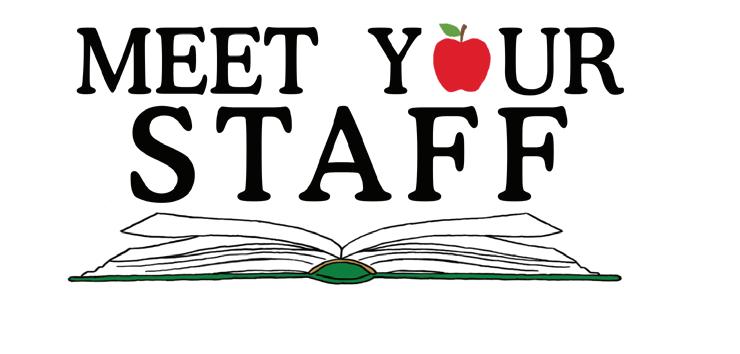
The Harker we know and love today began as Manzanita Hall. In 1893, Frank Cramer started a college prep school for boys called Manzanita Hall in Palo Alto. Catherine Harker followed suit and created Miss Harker’s School for Girls in 1902.
Manzanita Hall briefly lost its name when the school was renamed to the Palo Alto Military Academy. In 1955, Miss Harker’s School for Girls began accepting boys and became the Harker Day School. After the Harker Day School and the Palo Alto Military Academy merged in 1992, the Harker School, as we know it today, was officially established.
The new Harker School opened up its Saratoga campus in the early 90s, operating as a K-8 boarding and day school, with Manzanita serving as the dormitories. History teacher James Tate attended Harker from kindergarten through fifth grade as a day student.
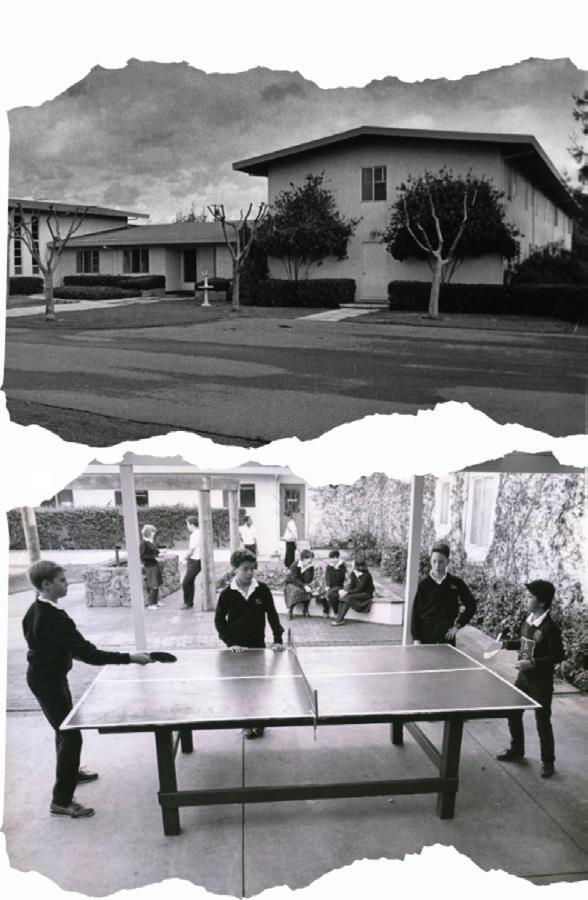
“It was so surreal and so different that I basically didn’t recognize the place.” Tate said. “Most of Manzanita was dorms for international students that lived on campus. Where the cafeteria is now, was a pottery studio. Right next to that, the most desirable drinking fountain on campus was there because it had the coldest water on campus.”
Harker opened its high school grades in 1998 and converted Manzanita into a cafeteria. Teja Patil (’02), a member of the first graduating class, witnessed the transformation of Manzanita into a cafeteria and a space for friends to bond.
“We used to call it the edge,” Patil said. “We always found ourselves somewhere in the edge or in this little room in the back called the ledge where we just hung out and studied. I really loved it because it was like an informal space where people came together.”
In 2002, Harker discontinued its boarding program to create more space for the new upper school. The girls’ dormitories upstairs in Manzanita now serve as working areas for members of the Office of Communication. Visit harkeraquila.com for more.

Four campuses. One student body. One Harker community.
For Assistant Head of School for Academic Affairs Jennifer Gargano, they’re all part of one story. This belief shapes how Gargano approaches decisions that affect over 2,100 students. Constantly moving between campuses to support all teachers and division heads, Gargano believes that a schoolwide community is essential for the learning experience.
“The biggest thing for anyone in a K-12 role like myself is to make sure that we’re working with all the divisions, so it’s a well-articulated
experience, and we feel like one school,” Gargano said. “I get to work with so many teachers, division heads and staff. That’s what makes it exciting because we’re a school filled with really wonderful people, and I get to help everyone grow and work as a team.”
Gargano began her journey at Harker in 1999 as a mathematics teacher, when the upper school was only in its second year. After teaching for three years, she decided to step into an administrative role because she developed a deep connection with Harker.
“I really love this place, and when you really enjoy and believe in a place, you want to give the most that you can,” Gargano said. “I just want to be
the biggest part of this school that I absolutely can. That came more from a care about Harker than a grand idea of leadership.”
When making administrative changes, her first step is to gather the experts, teachers and division heads who will experience the impacts of the decision firsthand.
“We all have one perspective, meaning we can’t see every aspect,” Gargano said. “I have definite thoughts about what should or should not be done, but I am not naive enough to think that I know everything and can see everything from everybody’s perspective. It’s a very large place, and everyone has a different expertise that I don’t have and a different view of the school.”
Gargano’s belief in community extends to her work outside of school. She has served on the board of West Valley Community Services, a nonprofit resource center for the unhoused and food-insecure in the school’s zip code, for eight years. This role taught Gargano that community is a shared effort built on empathy.
“Something I find very important about community service is in a way, we all just serve each other,” Gargano said. “It’s not like any one of us is better than anybody else. People help me when I need help, people help all of you when you need help. We just give when we have extra resources or time because we’re all in this world together.”
Visit harkeraquila.com for more.
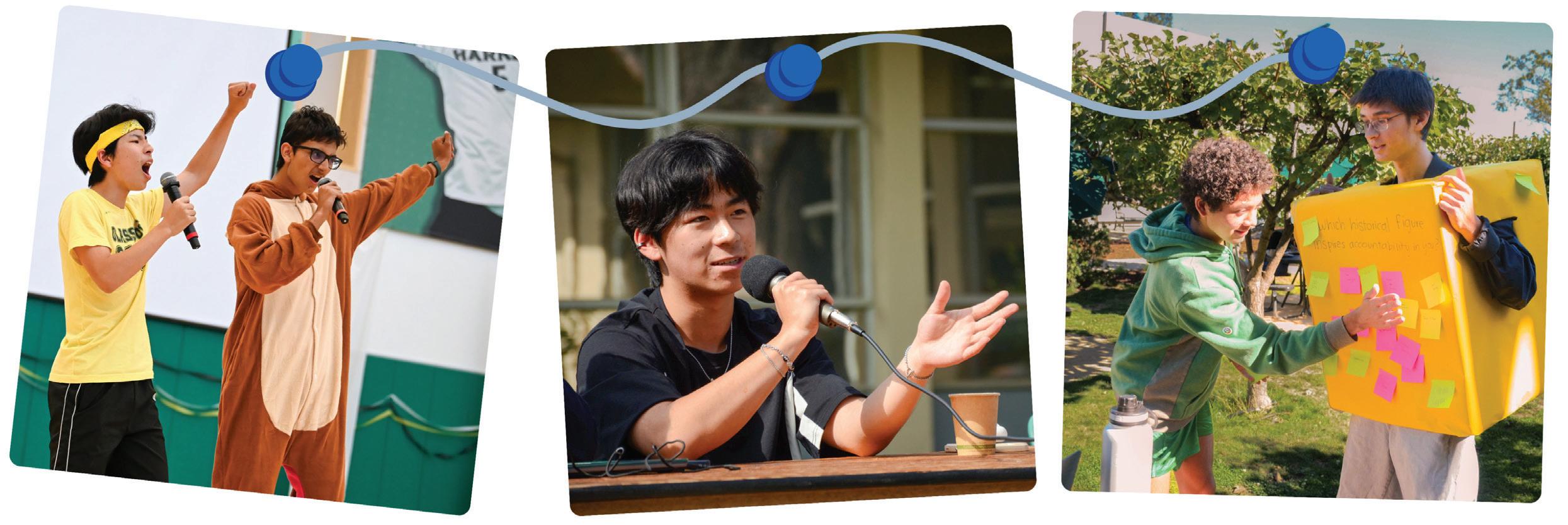
“CLC.” It’s an acronym that has been mentioned throughout the year in school meetings, emails and schoology posts. But what exactly is the Campus Leadership Coalition?
The group, formed under an ASB initiative, brings together the major leadership bodies on campus to coordinate projects, prevent overlap and promote a shared vision of unity.
The idea stemmed from a simple challenge: many student organizations were working towards similar goals but on separate paths. ASB Secretary Sophia Zhu (11) reflects on the fact that overlapping events and repeating initiatives revealed the need for a space where leaders could coordinate their efforts.
“ASB felt that something that needed to happen was more consensus among the different leadership groups
on campus,” Sophia said. “We felt that creating the CLC would be beneficial to keep us in communication with one another, and to promote transparency within ourselves so we present ourselves as a unified front to the whole student body.”
Since its creation, the coalition has brought together the Associated Student Body, Student Council, Honor Council, Student Diversity
Coalition, Green Team and Spirit Advisory Board.
“All the groups gathered in midAugust and thought about what our community does well and where there are opportunities to grow,” Director of Student Organizations
Eric Kallbrier said. “The enthusiasm around that process, the openminded discussions and the critical thinking about our community was really inspiring and really says a lot about the elected student leaders.”
Visit harkeraquila.com for more.
Puerto Rican superstar
Bad Bunny won “Album of the Year” and four other trophies at the Latin Grammys on Nov. 13 for his latest album “DeBÍ TiRaR MáS FOToS”. He held the record for most-streamed artist on Spotify for three consecutive years. Nonetheless, the NFL’s decision to select him as the headline performer for the 2026 Super Bowl LX halftime show provoked a divided reaction.
For fans, the announcement created a moment of celebration and pride.

“I was very excited when I heard about it. He’s popular in the mainland community we have in the U.S.,” Bad Bunny fan Jessie Valdivia (10) said. “It’s fair for us to have somebody that would represent us. It’s a good opportunity to expose him to the whole country.”
Criticism for being “unAmerican,” only singing in Spanish or failing to represent “family values” followed the announcement. A Change. org petition to replace Bad Bunny with country music
111,408
star George Strait received over 111,000 signatures. Commenters expressed dislike or unfamiliarity with his music.
“He’s performing in Spanish, so to people who don’t understand Spanish, I can see that’s a viable concern,”
Bad Bunny fan Tanay Agrawal (11) said. “I also think it’s just because he’s Latin American. In their minds he’s not American.”

to remove Bad Bunny from 2026 Super Bowl halftime performance
Source: Change.org signatures
Although Puerto Rico is culturally and linguistically distinct from the mainland, Bad Bunny holds U.S. citizenship. His political advocacy and criticism of the U.S. government over topics like ICE’s targeting of
sociopolitical causes.
“He’s been an activist and a vocal supporter of various communities in the U.S. — the immigrant community, the Latino community, the LGBTQ+ community,” Olivas said. “So he’s been labeled by the far right and MAGA as an enemy.”
Bad Bunny chose not to plan any concerts in the continental U.S. for his upcoming international tour commencing Nov. 21, voicing concerns that his majority-Latino fanbase would be targeted by ICE. He instead hosted a month-long series of concerts in Puerto Rico from July to September,
“She’s literally the most unattractive woman he’s dated.”
“They make absolutely no sense on paper.”
“It has to be PR, right?”
These are only some examples of the tweets and Reddit posts that circulated throughout the Internet when acclaimed actor Timothée Chalamet began
supporting its local economy and encouraging fans to travel to the island.
“He’s been labeled, by the far right and MAGA, as an enemy. They won’t want him to be given a platform.
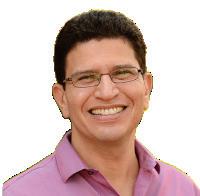
ABEL OLIVAS
SPANISH TEACHER, DEPARTMENT CHAIR
“ICE coming into his concerts and doing what he would see as discriminating and violating human rights,” Olivas said. “He’s not interested in creating that sort of situation,
but it’s interesting that he’s willing to do the Super Bowl. But that’s a different scenario since it’s a mixed group of people.”
Bad Bunny’s performance comes at a time when discussions of immigration and national identity are prominent in America. LatinX Affinity Group Co-President Sofia Vasquez Perez (12) explains how controversies around Bad Bunny’s upcoming performance reflect a larger cultural tension in the U.S.
“He’s shown a sense of power to those who can’t speak up around him,” Sofia said. “The Latin American community feels so connected to him and he’s such an advocate for immigrant communities. [The U.S.] is a land brought up by immigrants. We just have turned a blind eye.”
dating reality TV star Kylie Jenner in late 2023. Chalamet’s fan base immediately expressed disappointment and disbelief, and some fans called the relationship fake and attacked Jenner on social media.

Incidents of backlash like these illustrate the trend of celebrity obsession in certain niche fan groups. Junior Dhanya Ramanan sees how fans often form parasocial relationships with public figures.
“This kind of familiarity stems from this idea that we know celebrities,” Dhanya said. “But we have no idea how any of these people are in real life. We know a select facet that they have chosen to expose to the greater world, and the idea that we can determine anything about their identities from that is just ludicrous.”.
Because famous figures in the entertainment industry often interact with their fanbase through promotional events, fans may feel a false sense of emotional intimacy with their idols. To protect their relationships, some celebrities strive to completely separate their private and public lives.
Senior Janam Chahal argues that public figures shouldn’t
keep their relationships a secret for fear of backlash. She believes that fans should be the ones changing their obsessive behaviors, not celebrities.
“The celebrity’s decision to share information about their relationship shouldn’t be dependent on what random people on the internet think about them,” Janam said. “At the end of the day, they deserve to share as much or as little as normal people would. The fault lies in the hands of the public making assumptions about the situation rather than what the celebrity chooses to share.”
Sophomore Sid Gaur believes that celebrity relationship gossip can serve as a harmless form of entertainment and a lighthearted way to de-stress.
“If fixating on celebrities is your cup of tea, then go for it,” Sid said. “However, making your entire personality about your view on the celebrity is not great.” Visit harkeraquila.com for more.
When truth becomes treason
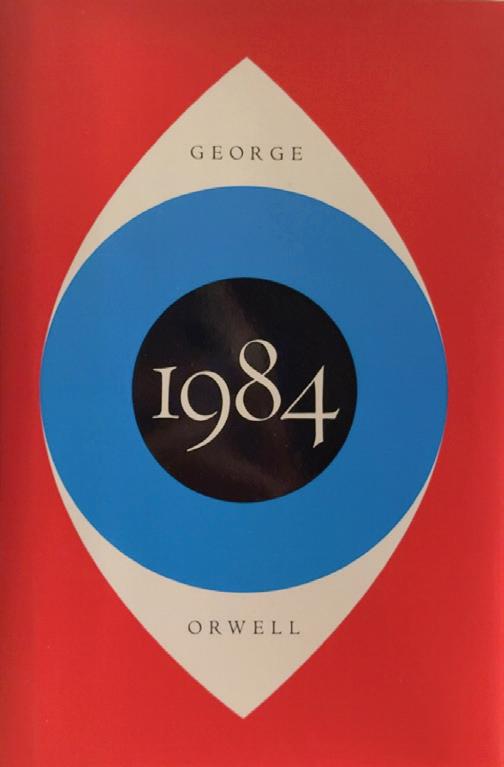

aileen jang
Freedom has rotted merely into a myth, and the smallest sparks of love or conscience are now crimes punishable by the state. Life in Oceania is a vacuum of emotion and even memory, where truth bends to power and individuality disintegrates into obedience.
George Orwell’s “1984” follows the narrative of Winston Smith, an ordinary worker at the Party, Oceania’s totalitarian government led by the omnipresent leader Big Brother. While everyone around him mindlessly conforms to the Party’s ideology, Winston begins to notice the contradictions that define daily life.
“The United States, a democracy once built on liberty, creeps towards an Orwellian dystopia.
While Orwell wrote his dystopia in 1949, I noticed many glaring parallels with the modern world when I was reading this book over the past month. Our current government abuses their power to serve their own interests. Like the people of Oceania, the citizens of America seem at risk of believing whatever propaganda is fed to them.
As the unsettling connections between our world and the universe of “1984” become even more obvious, it is clear that the tale is not as fictional as people believe it to be. The United States, a democracy once built on liberty, creeps towards an Orwellian dystopia.
Winston clings onto his desire for human connection. He keeps a secret diary, engages in a forbidden love and attempts to join a resistance movement. Through Winston’s futile struggle for freedom and love, Orwell reminds us how fragile our ability to think, question and feel is.
“1984” left me asking if we were faced with such oppression — would we resist, or would we learn to love Big Brother?
Visit harkeraquila.com for more.
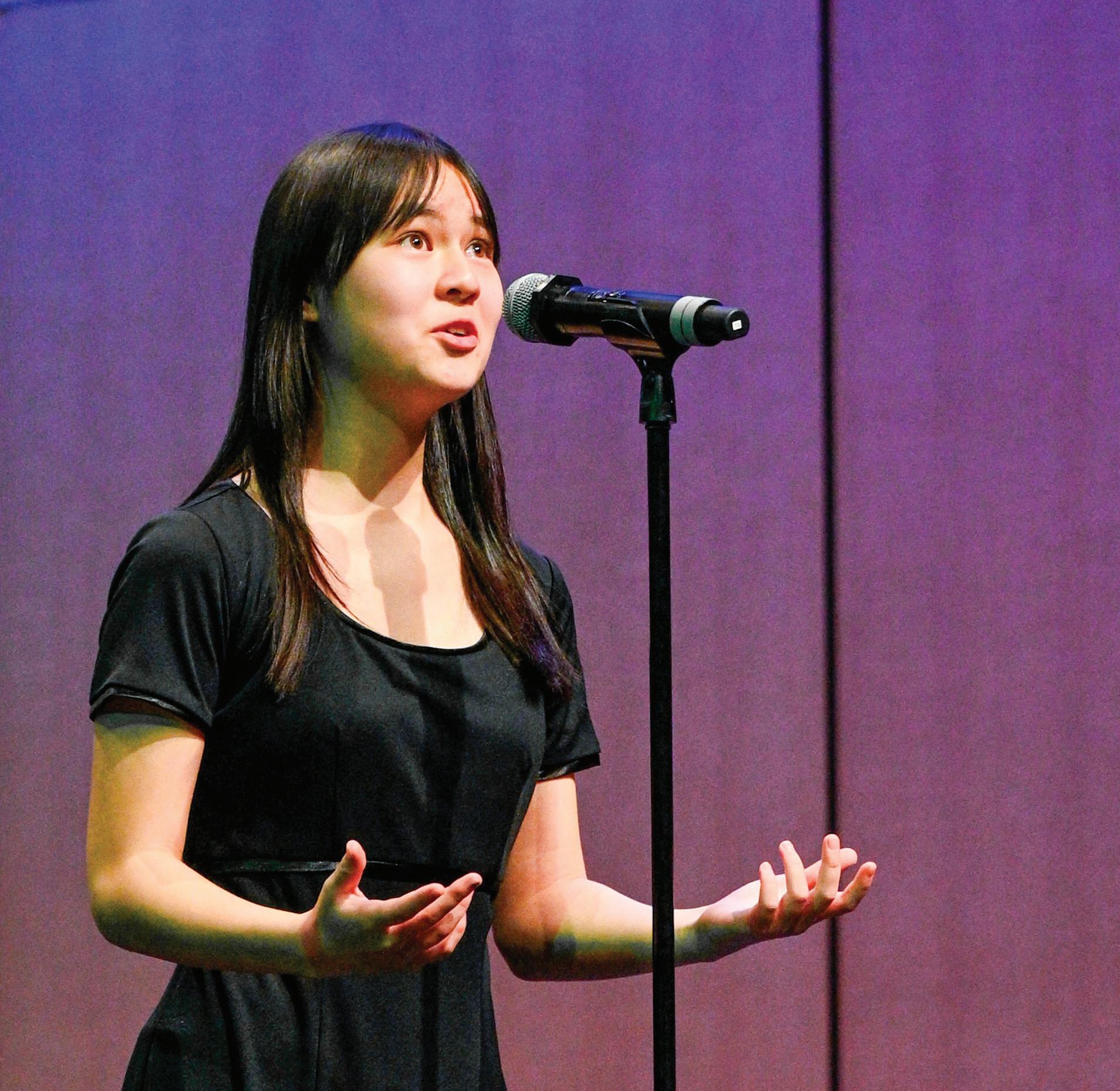
Asoft violin note resonates through the hushed theater. With a steady crescendo, 80 voices intertwine to form the layered harmonies of “Baba Yetu,” a piece based on the Swahili version of the Lord’s Prayer. Together, they create a warm and intricately detailed sound, inviting the audience to explore music from around the world.
The fall choral concert brought “Global Movements” to the Patil Theater on Nov. 13. Featured choral groups included treble chamber choir Dolce Voce, tenor and bass choir Rhapsody, and all-voice choirs Capriccio, Downbeat and Festival Chorus.
Throughout the show, groups sang pieces from many
lily shi & chelsea xie
English teacher Susanne Salhab’s AP Literature students performed scenes from Sophocles’ play Antigone in the Nichols Auditorium on Nov. 12.
Students worked in pairs or trios to reenact moments from the play that illustrated key plot elements. While students had created annotated plot mountains for Antigone in previous years, Salhab introduced live performances this year to encourage more creative and personal engagement with the narrative.
“What I find so exciting is that students were willing to think about English in a different way,” Salhab said. “I wanted them to think, ‘How can I show what I understand about a character by being that character?’ That’s a different way of thinking about literature.”
The scenes ranged from Antigone’s defiant exchange

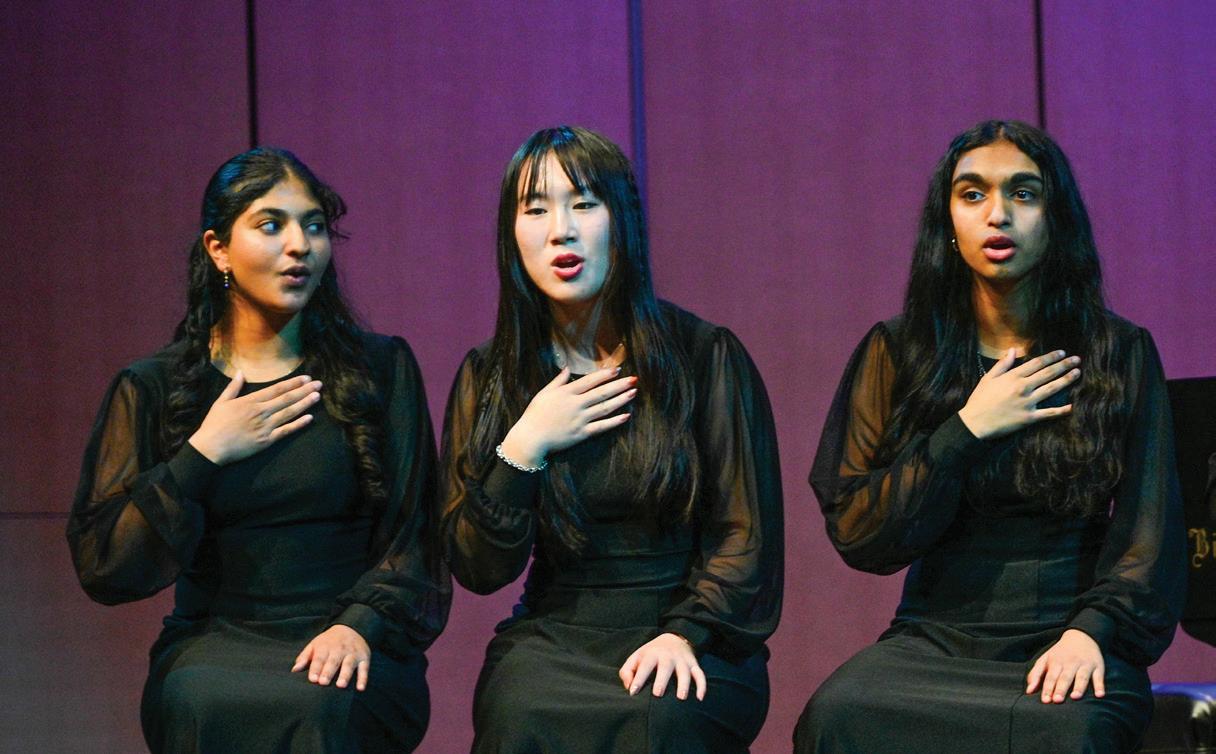
different countries. Senior Simon Kirjner arranged Jacob Collier’s “Little Blue” for Downbeat. This piece from Collier’s multicultural album “Djesse Vol. 4” incorporates different instruments like the balalaika and agogo bell in its complex polyphony.
“I spent a lot of my summer listening to the piece, listening to other versions of it, and creating my own,” Simon said. “It’s a very difficult piece. There are a lot of interesting harmonies that pop out. I’m really happy with the work we put into it, and I am beyond happy with how it turned out. It’s so crazy to me that it’s something I produced and put work into, and now this is the product.”
At the end of the show, all choirs came together for a rendition of “Baba Yetu” from
with her sister Ismene, marking the beginning, to King Creon’s devastation upon discovering his son’s and wife’s deaths, closing the play. Students took creative liberty with their scenes and placed them in settings far removed from the play’s traditional ancient Greek world.
Senior S Wang, who played Antigone in the climactic moment where Creon finds his son Haemon’s dead body, enjoyed seeing familiar scenes represented in new situations.
“The purpose was to think more deeply about how the characters have affected each other and how ‘Antigone’ can be pulled out of its original setting into so many other contexts,” S said. “Seeing the lessons and the power dynamics and the consequences faced by the characters across so many different dimensions and universes goes to prove why this play is such a classic.”
Before acting out the scene, each group presented a literary
the video game “Civilization IV.” This final performance had instrumentalists playing
It’s so crazy to me that it’s something I produced and put work into, and now this is the product.

SIMON KIRJNER DOWNBEAT MEMBER
the drums, flute and violin. Capriccio alto Lauren Xi (11) played a drum instead of singing for the performance, noting the difference in their role.
“It was definitely more
of a challenge to keep myself grounded and to watch Ms. Sandusky at all times to make sure I was on the beat,” Lauren said. “It’s a lot more noticeable if you, as a very loud percussionist, make a mistake, as opposed to if you are singing in a group of 80 people. But I also enjoyed it a lot because it challenged me and it was fun to push myself.”
During the final dress rehearsal, members from all different choirs sat in the audience and supported other groups during their performances. Lauren highlighted the importance of connecting with fellow singers in this way.
“Hanging out with other choir members is really conducive to singing as a group,” Lauren said. “It helps you connect with each other.”
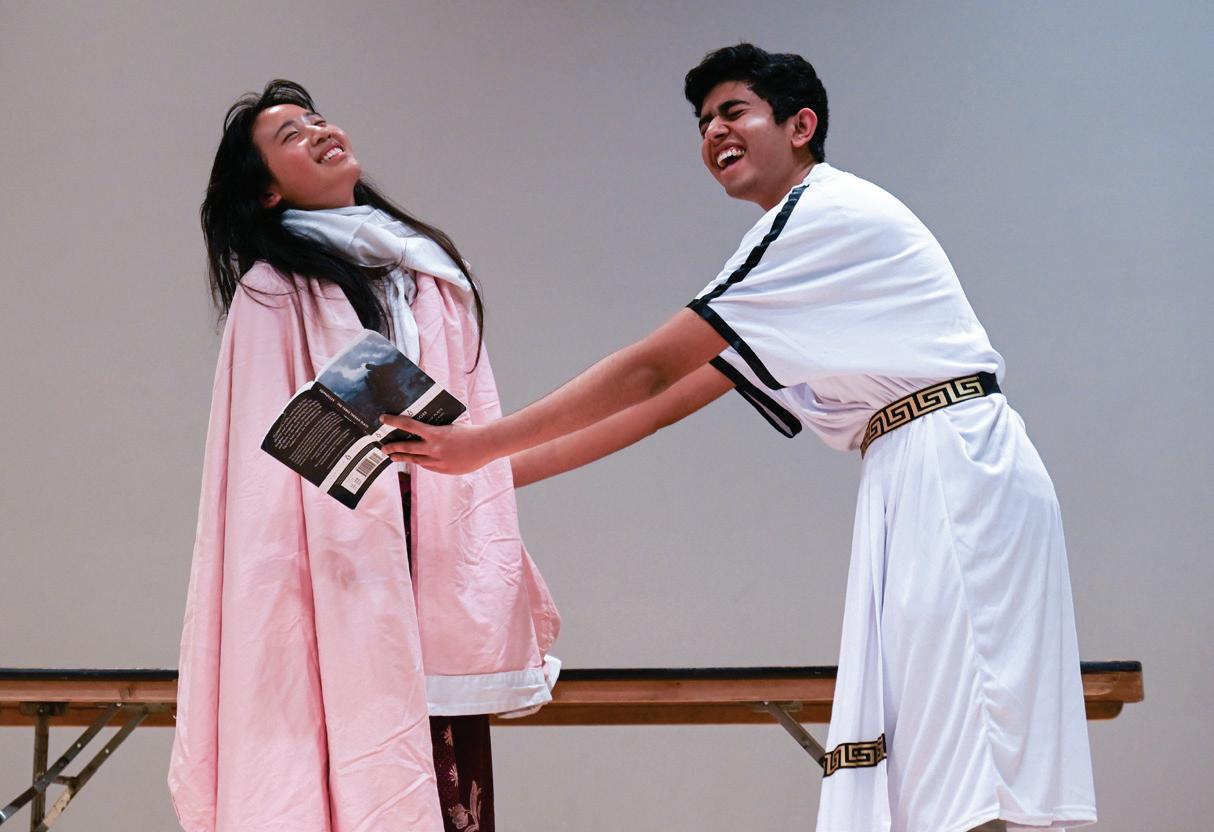
analysis that outlined the scene’s significance, pointed out literary techniques and explained the motivation behind costuming and staging choices.
For S, the most fun part of the activity was portraying the drama of the scene on stage and seeing the audience’s response.
“It was so great to get the reactions from the audience like
laughter and smiling,” S said. “For those in the audience that were in my class, it’s great for them to see it visually. For all the external audience members who came to support and watch us, I think they also enjoyed it a lot because we tried our best to explain everything and show the plot in our acting.”
Visit harkeraquila.com for more.
You stare at the essay draft on your screen. It’s a mess: the wording is awkward and cluttered, and the structure is underdeveloped.
You can already see the hours slipping away as you painstakingly revise sentence by sentence, all in pursuit of something barely passable. Or you could simply open a new tab, paste the draft into ChatGPT and watch it return a polished, articulate essay that says everything you struggled to express. With just a few edits, it’s ready to turn in, returning a higher grade without the exhaustion.
Using a chatbot to polish phrasing will not have the same effect as generating an entire essay from a prompt.
The thought has crossed my mind, too, especially during my busiest weeks, when it feels like I can’t squander even a minute. Like many students, I’ve asked myself: why would I spend hours on something that can be accomplished in a few minutes?
The rise of chatbots has undeniably transformed how we work and learn: AI has probably saved me hundreds of hours of reading dense papers and debugging thousands of lines of code. It’s no surprise that people now turn to chatbots
for everything from cheating on assignments to conducting groundbreaking research.
However, research published this year has revealed a dangerous consequence of this growing reliance. In a UK study of 666 participants, heavier AI use correlated with significantly lower scores on critical thinking measures. In an MIT study, 54 participants wrote essays either unaided, with Google Search or with ChatGPT while wearing EEG headsets. The results showed that ChatGPT users displayed the weakest and least distributed brain connectivity. Over repeated sessions, they demonstrated lower neural activation and weaker memory recall.
Critical thinking is a cognitively expensive process: recalling what you know, considering alternatives and challenging your assumptions is hard work. When you offload this struggle to a machine, you bypass the effort that strengthens your mind, weakening your capacity for deep thought.
Of course, using a chatbot to help brainstorm arguments or polish phrasing will not have the same mental effect as generating an entire essay from a prompt. But even small tasks, when repeated, can quietly erode our cognitive independence. While each skipped mental step may seem insignificant, over time it can accumulate into habit until the reliance becomes automatic.
grow, to the point where I’ve seen peers using ChatGPT in class discussions to generate comments instead of forming their own. Is it that difficult to rely on your own mental processes to come up with a response? For some, AI has become not just a time-saver, but a way to avoid the discomfort of thinking itself.
Thinking is slow and uncertain and requires confronting the possibility of being wrong. The danger of replacing that
doubt with effortless certainty is once we grow used to it, the struggle of genuine thought begins to feel intolerable. We start to conflate a lack of struggle with intelligence.
It’s hard to step away from AI when it saves so much time, and it’s unreasonable to completely cut out AI usage in a world that is increasingly built on it. But protecting your ability to think critically begins
with a recognition that it’s at risk and a willingness to go out of your way to preserve it. When the impulse to let AI solve your problems inevitably arises, resist it. Conversely, when AI is used with intention, it can challenge your thinking rather than replace it. Taking a few extra minutes or hours to reason through a problem may seem inefficient, but in the long run, it sustains something far more valuable: the strength of the human mind.
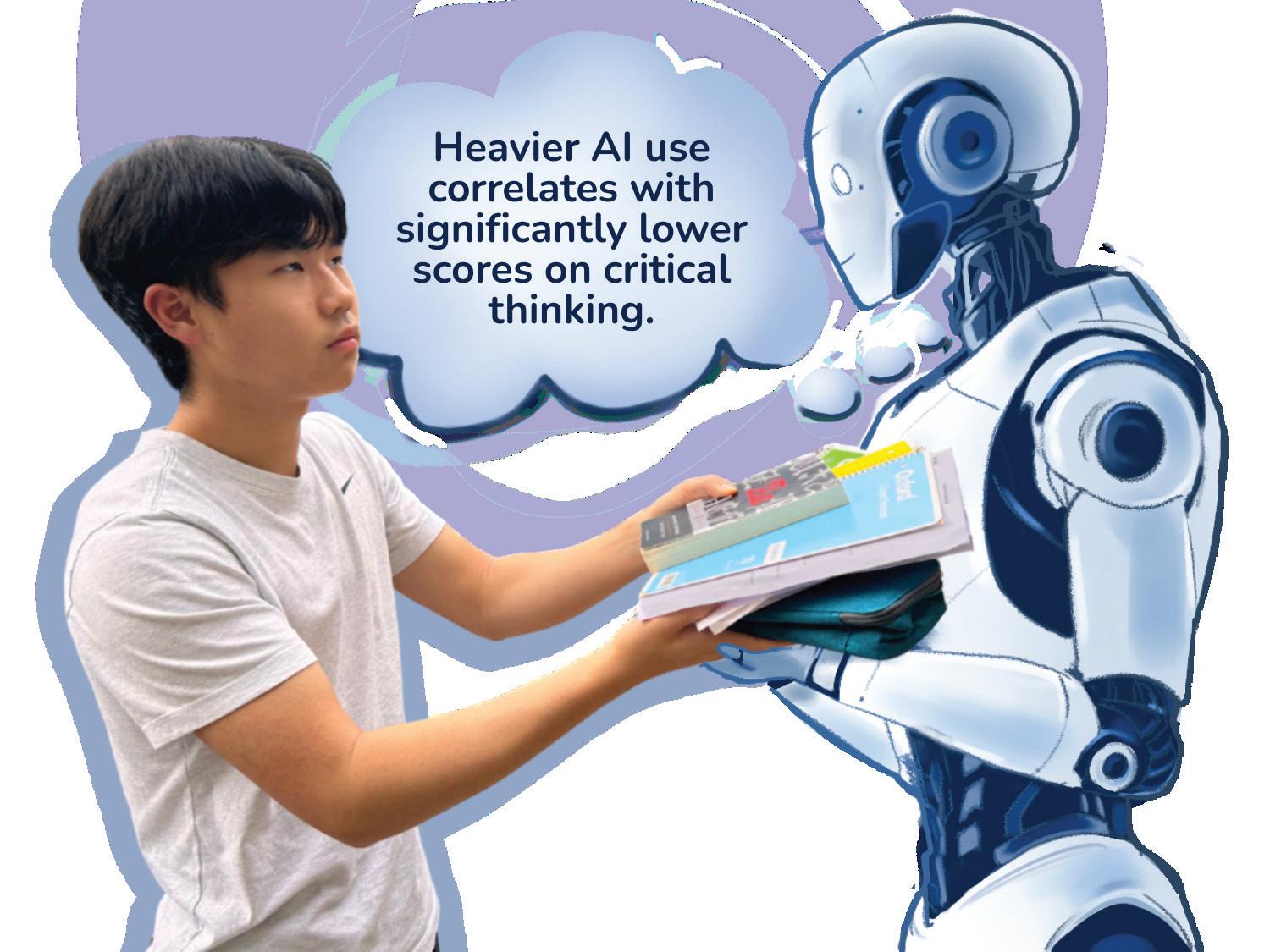
Over the past few years, I’ve witnessed that dependence
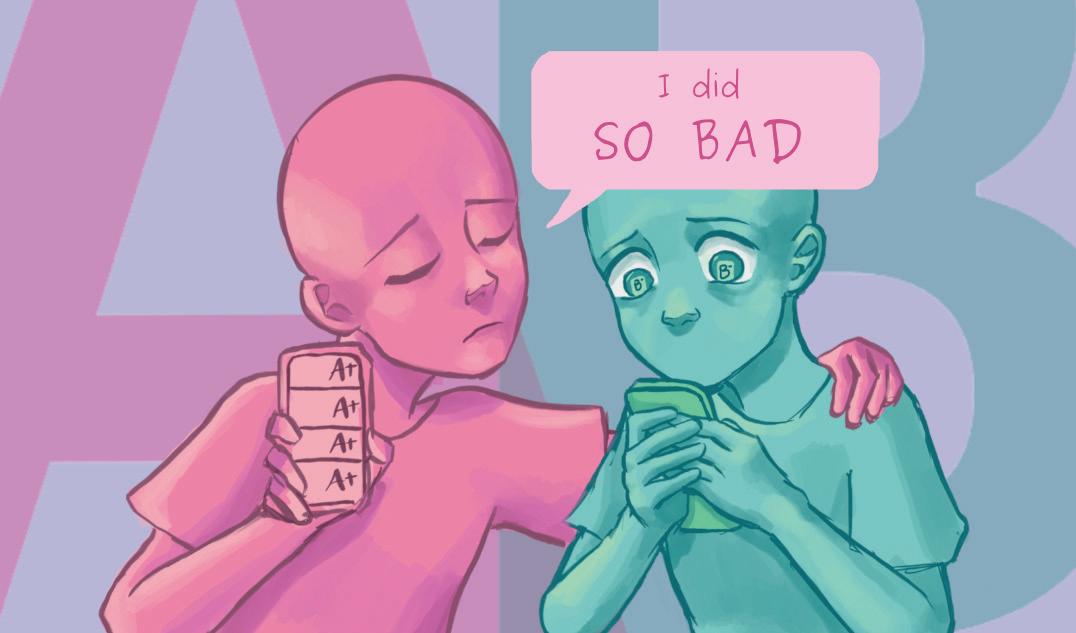
doing so well, the only way to stand out is to downplay your wins to make them look even
kanav gupta
I’ll be honest — I’ve said this classic line before: “I did so bad….only a 96.” It slips out after nearly every test at Harker. But lately, with tests and assignments in full swing, I’ve started noticing just how strange and damaging it is, because, frankly, no one I know who gets a 96 truly feels like they failed.
At Harker, saying “I did so bad” when you didn’t isn’t about insecurity — it’s about subtle
signaling. It’s a form of quiet and backwards bragging. There is an unwritten rule at most schools: you can’t brag outright, so why not brag in reverse?
When someone says, “I only got a 93,” what they’re really saying is: “My baseline is an A+.”
The complaint itself is a flex, telling everyone how high your standards are and reminding them how consistently well you perform. And it works. Arrogance gets punished, but selfdeprecation? That gets rewarded.
I’ve watched classmates get flooded with reassurance the moment they pretend to complain about less-thanperfect scores. Instantly, others scramble to comfort them, applauding the impressive score they’ve downplayed, all because the brag was dressed up as selfdeprecation.
We must normalize honest pride. Admitting that someone worked hard should be as acceptable as disappointment in a grade. Being proud is not arrogance, it’s transparency.
When someone starts humble-bragging, we have to stop showering them with reassurance. Just neutralize it: “That’s a good score, you don’t need to downplay it.” If we stop rewarding fake humility, the quicker this mentality dies out. It’s happened to me before. I’ll say I failed just to hear someone tell me I didn’t. Then it hits me: this humblebrag culture is not about honesty or humility; instead, it’s an elaborate performance in pursuit of approval.
“I’ve watched classmates get flooded with reassurance the moment they pretend to complain.
At a school like Harker, excellence is expected. When everyone is already doing so well, the only way to stand out is to downplay your wins to make them look even larger. Acting like an achievement is no big deal becomes the new way of signaling that a student is performing at a high level all the time, effortlessly. This is all a part of the
new wave of “nonchalance culture,” the idea that effort is embarrassing, that hard work should look effortless. Nobody says, “I studied like crazy for that test and I’m proud of how I did.” That kind of vulnerability feels almost taboo. We only talk about effort when we don’t do well, not when we succeed.
For someone who truly struggled on that same test, hearing a classmate’s disappointment over a 96 feels like a slap in the face. I have been on the opposite side of humble-bragging: a classmate turns to me, disappointed about their 95 grade on their essay, while I sit in silence with my 90. It converts someone else’s goal into your failure.
Somewhere in the middle of this fake modesty, authenticity disappears. Even when we win, we can’t be honest about it. We’ve turned success into an act — something to frame for the public to approve.
Sure, the easy answer is to just not talk about scores. However, at a school like Harker, people will always talk about score. The least we can do is make these conversations honest, not performative. If we are really proud of what we have achieved, we shouldn’t have to disguise it as disappointment.
ashley mo, emma li & jonathan szeto
50% Off! Buy now! You won’t want to miss this offer! Right after Thanksgiving, the annual rush begins. Inboxes and social media feeds fill with a barrage of “can’tmiss” deals, and everyone races to buy items they didn’t know they originally wanted.
One thing to be careful of is that prices will rise soon. It is designed to create the image that this price must be good because they’re advertising it so much.

of respondents indicated that they purchase items they want, only 15.7% of respondents said they buy items they need. People often end up buying items in the heat of the moment from the pressure of wanting to get a good deal, instead of actually considering if it’s something they truly want in the long term.
Frosh Jessica Xu states that the overwhelming majority of “wanters” at Harker influences her outlook on spending money. While she often sees social media influencers with trendy items, she finds that upon seeing their posts, she has to pause and question whether she genuinely likes the product or is simply drawn to the person promoting it. That same critical mindset carries into her daily life at school, where the abundance of popular items pushes her in the opposite direction.
“The consumerism [at Harker] kind of convinces me to not buy things,” Jessica said. “When I see a
Cyber Monday. Junior Phoebe Lee noted that to prevent this feeling, she often starts looking for items she


Address: 500 Saratoga Ave, San Jose CA Tel: (408)249-2510




producers learned to induce mass interest through tactics like opening at odd hours or offering early-bird discounts, and many even pushing low-quality products by making them seem exclusive. “Flash sales” became a psychological tool.
often do you regret a Black Friday purchase?

shoes, I wear them a lot. For makeup, I use makeup slowly, but they also
However, the truth is that most of what people buy during Black Friday or Cyber Monday do not last, whether in their homes or their lives.
According to the same survey, 32.3% of students who purchased items during these shopping events said they use them occasionally. This trend has pushed some students to approach Black Friday sales with more intention and
“Before Black Friday, around 1 or 2 months before, I try to make a list of all the things that I want at that time,” Jessica Xu (9) said. “When Black Friday actually comes, I think about if I still want these things, and if I still do, then I’ll probably get them, but if I don’t, then I won’t. Most of the things that I get are plushies, decorations or collectibles, and I don’t regret [buying] them because sometimes I’ll just look at them and it makes me really happy.”
In the age of the internet, a large portion of Black Friday shopping has moved to be fully online. On the internet, where companies have access to buyers’ browsing data, businesses are able to much more easily manipulate prices of certain goods that appeal to certain consumers in order to maximize profit. This causes many buyers to spend much more than they would have otherwise, with companies taking advantage of shoppers’ maximum willingness to pay for an appealing product.
According to economics teacher Sam Lepler, common profitmaximizing tactics by businesses include raising prices ahead of Black Friday and then lowering it later. Another strategy is anchoring, pricing a visibly-worse decoy product and the actual product at similar prices to make the normal product seem like a deal. Retailers further create a sense of franticness with the idea of the limited-time sale, leading shoppers to make a difficult decision: buy now, or lose out.
“One thing to be careful of is the idea that prices will rise soon,” Lepler said. “That ‘hurry, hurry, hurry’ is often not true. A lot of times, like a week after Black Friday, stuff is returned and then they’ve got to get rid of it, so the deal is actually even better post Black Friday. But that hurry, hurry, hurry is designed to create this image that this price must be good because they’re advertising it so much.”
Buyers can consider that deal may not be a deal if the product is not one they desired before taking into account the sales. In the frenzy of Black Friday, many find themselves buying products they would not care about in the long run, influenced by the need to benefit from deals.
“Companies make you think this is the deal of a lifetime and it’s only going to happen on Black Friday,” AP Psychology teacher Jeff Sutton said. “If you don’t go that day, you feel like you’re going to miss out forever. That sense of scarcity is incredibly effective at pushing people to buy.”






These personal approaches to managing purchases on Black Friday contrast sharply with how the day itself was shaped by decades of marketing and economic strategy.
The term “Black Friday” originally emerged in Philadelphia in the 1950s, representing the chaos on the
Sutton also noted that buyers’ fear of missing out, commonly known as FOMO, may drive them to purchase products unnecessarily. Whether students see classmates with the newest technology, or people see their friends and family showing off recent purchases, the anxiety of being excluded from an experience shared by people nationwide can pressure individuals into buying things they never planned to.
“If everyone’s out there getting these great deals and you’re not,

If I buy clothes or shoes, I wear them a lot. I also use up the make up I buy.
what everyone else is doing.”
Others find themselves enthralled in the experience of mass buying during flash sales. Sutton explained that some shoppers are motivated by the rush of competing to take advantage of discounts before someone else claims them. This competitive atmosphere can turn shopping into a challenge rather than a necessity.
“For some people, Black
When you buy something on sale on Black Friday, do you feel more like you need it or just want it?

Phoebe Lee (11)
I mostly get plushies or collectibles, and I don’t regret them.

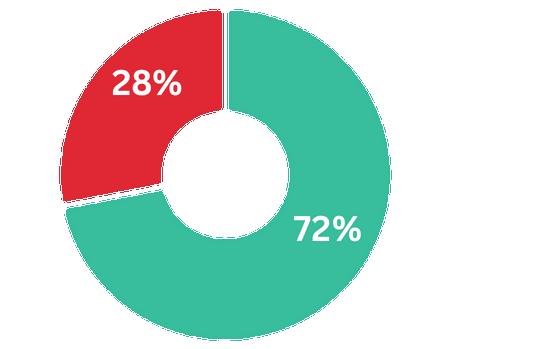



Jessica Xu
(9)
Try not to impulse buy. If something can wait, let it. Don’t fall for the immediate gratification.

Jeff Sutton PSYCHOLOGY TEACHER















Wow, you’ve grown so much! You’re so skinny, have you been eating enough?” Faces I’ve never seen in my life jostle me around the room, shouts of exclamations in Chinese ringing in my ears. As is typical of a Chinese family gathering, at least 20 relatives crowd around the table, all talking to me at once. I’m totally lost in the complex dialects, and as I struggle to respond, all I manage is stuttering and half-English phrases. I laugh and make vague gestures, desperately trying to mask my broken Chinese and wishing I were as fluent as my
cousin, who grew up speaking it at home.
The rest of the dinner goes the exact same way, each grandparent passing by to interrogate me on my life in America. My heavy accent is obvious and I barely form a coherent sentence, leaving me feeling disconnected as I listen to the bustling conversations around me.
Although I went to Chinese school as a child, I never appreciated its value, shrugging off the lessons as irrelevant. As I retreat into the corner of the room, I think back to those classes and regret not paying attention. If I had put more effort into learning about

LIFE OF WONDER I try to experiment with my hobbies and what I do in every aspect of my life.
Reaching into the library bookshelf, I inhale the musty scent of old pages and glance at the title in my hand. A glossy book about the difficulties of retirement in 2025. With no knowledge of finance at all, this nonfiction explainer isn’t my usual style — but it seems extremely relevant to the
economy today, so I shrug and put it in my bag along with the 10 other novels I’ve discovered in today’s haul. Every week, I try to pay a visit to the library and browse the shelves. I don’t believe in overreliance on book recommendations or in planning out what I’ll borrow ahead of time. Instead, I wander through the library for hours, peering at book spines and wandering among catalogues of novels until I fill my bag. Through this method, I can move past popularity or reputation to find hidden literary treasures. In this same vein, I try to experiment with my hobbies and with what I do in every aspect of my life. From sewing stuffed animals to playing with dental blue lights, from taking on a role as an egotistical shapeshifting older sister in a short film to chasing leads at a local newspaper, I am always open to new activities and obsessions, even while spending the majority of my time in school.
the language and culture, maybe I would remember the content and be able to connect with my relatives more closely.
The impact of Chinese culture is undeniably important in students’ lives too. The
“Simply cultivating the desire to learn from your family a little more can make a huge difference. ”
disconnect between relatives in China and America proves one of the biggest consequences of
not learning Chinese. Without the ability to communicate, it’s difficult to forge a bond with family members whom you’d otherwise learn from. Unwritten stories of childhood memories and traditional recipes are lost to time, irretrievable experiences that disappear forever.
It’s no secret that many Harker students are Chinese, but surprisingly few are proficient enough to read and write. With a schedule packed full with academics, most simply don’t have the time to learn Chinese, much less the traditions that are tied to it. In a survey of 127 Chinese students at Harker, 27% considered themselves to be advanced in reading Mandarin,
with only 20% advanced in writing.
I often hear students complain that languages are difficult to learn, but many also regret not learning the culture as thoroughly. In the survey, one student wrote that “I want to be closer to my heritage, but my Chinese classes (which are outside of school) are extremely boring.” Another wished that they had learned reading and writing, as they felt they lost part of their identity. One respondent argued that proficiency tests do not reflect a student’s ability to talk with a native speaker, while another mentioned that although Chinese is tedious to learn, it “connects me to a history thousands of years old.” I started Chinese school in first grade, spending years bent over the monotonous Chinese workbooks. In sixth grade, I felt that it wasn’t worth my time and quit. Recently, I reconnected with the language in an AP Chinese class outside of school. My teacher, a passionate advocate for learning Chinese culture, forced us all to read articles on aspects of Chinese culture. Everything from pandas to Chinese school systems inspired me to keep learning. My teacher often encouraged us to talk to our parents and grandparents in Chinese, to ask about their life. I didn’t realize it at first, but the small act of conversation helped connect me to my family much more. Simply cultivating the desire to learn from your family can make a huge difference. Putting down your phone and asking your parents about their life in China could bring a discussion that wouldn’t have occurred. Even if you don’t want to learn the language, understanding the culture behind it will improve your connection with relatives.
On Diwali, a major Hindu holiday, my house filled with sounds of celebration. In the kitchen, plates clattered as my mom made plates of mithais, sweets. In the living room, the hum of voices grew louder with each guest’s arrival. Diyas glowed in the windows, and bright rangoli, a colorful sand design, at the door welcomed friends into our home. Yet, all of the celebration was taking place a floor beneath me. While the sounds of Diwali drifted up the stairs, I hunched over my desk, my face lit up by my laptop screen. From where I was sitting, the festival of lights felt dim in a way it had never before.
That night, I felt a growing disconnect from my culture. I realize that my situation wasn’t unusual. When assignments fall near ethnic or religious holidays, students are forced to choose between academic expectations and family traditions.
Despite our diverse community, teachers often assign major deadlines on cultural holidays, creating

PROTECTING CULTURAL TRADITIONS True inclusivity means that academic demands do not come at the cost of being present. Looking back on Diwali, I realize I missed a moment I cannot recreate.
unequal expectations for which students must balance schoolwork with important traditions. For some, this means missing family dinners on Lunar New Year or Eid morning prayers because a test can’t be moved. When academic schedules make time for mainstream holidays but overlook others, it creates an imbalance in whose celebrations are acknowledged. True inclusivity means academic demands do not come at the cost of being present. Heavy workloads during cultural holidays can create
stress, as the pressure to stay academically focused overshadows the chance to be emotionally present with family. Looking back on Diwali, I realize I missed a moment I cannot recreate. To prevent experiences like this, our community has to be more intentional: learning which holidays students observe and avoiding major assessments on those days is a step in the right direction. They give students permission to honor the traditions that shaped them without feeling guilty or torn.
Visit harkeraquila.com for more.

Editors-in-Chief
Tiffany Zhu Ashley Mo
Managing Editors
Jonathan Szeto
Emma Li
News Editors
Samuel Tong
Nathan Yee
Assistant News Editors
Liana Barooah
Aileen Jang
Opinions Editors
Elizabeth Zhang
Risa Chokhawala
Assistant Opinions Editors
Grace Wu
Leah Krupnik
Aahana Sharma
Sam Li Features Editors
Assistant Features Editor
Dyuthi Vallamsetty
A&E/Lifestyle Editors
Cynthia Xie
Chelsea Xie
Assistant A&E/Lifestyle Editor
Shreyas Karnam
Claire Tian STEM Editors
Caden Ruan
Assistant STEM Editors
Saria Lum
Kanav Gupta
Sports Editors
Wenjie Zou
Lily Peng
Assistant Sports Editor
Charlene Li
William Jiang Copy Editor
Cynthia Xie
Lily Peng Photo Editors
Assistant Photo Editor
Aahana Sharma
Lindsay Li Multimedia Editor
Assistant Multimedia Editor
Liana Barooah
Whitney Huang, CJE Adviser
Aquila Editors-in-Chief
Lily Shi
Eva Cheng
Aquila Managing Editors
Suhani Gupta
Janam Chahal
Charlie Wang Mihir Kotbagi
Kairui Sun
Humans of Harker Editors-in-Chief
Ella Guo
Disha Gupta
Humans of Harker Managing Editors
Vivek Moorjani
Mendy Mao
Victoria Li Heather Wang
Reporters
Samaara Patil Emma Lee
Kristiyan Kurtev
Isabella Wong
For Harker students enrolled in the same course, the expectation is simple: each section should provide the same rigor and learning. Yet the reality is often more complicated.
Every teacher brings their own expertise and unique teaching style, which can lead to disparities in pace and overall learning. As a result, two students in the same course can have a completely different understanding of the material, simply because of the teacher they were assigned.
In a Schoology poll of 130 students, 110 respondents said that learning experience depended more on the teacher than the course itself. 101 students feel that teaching style varies significantly between teachers of the same course, and 69 believe grading standards differ heavily.
Because certain teachers favor different teaching methods, students can experience inconsistencies in information reception and engagement between classes. When one teacher leans

toward hour-long lectures while another prefers interactive activities, students’ experiences are not equal even when the same course appears on their transcript.
Departments across campus approach this issue differently. Teachers for STEMoriented classes like math and science, which inherently possess more objectivity in terms of curriculum and grading, collaborate on point distributions and curves for assessments. Physics 1 teachers, for instance, directly discuss and design their tests and quizzes together with each other so that students receive the same grade regardless of who grades their work. However, even with these precautions in place, the teachers’ methods of teaching concepts can lead to discrepancies in performance and education.
The issue becomes more apparent in humanities classes, which have a built-in subjectivity largely dependent on individual teachers’ preferences and stylistic choices. English teachers strive to assign similar types and frequencies of assessments, but in reality one classroom may emphasize the revision
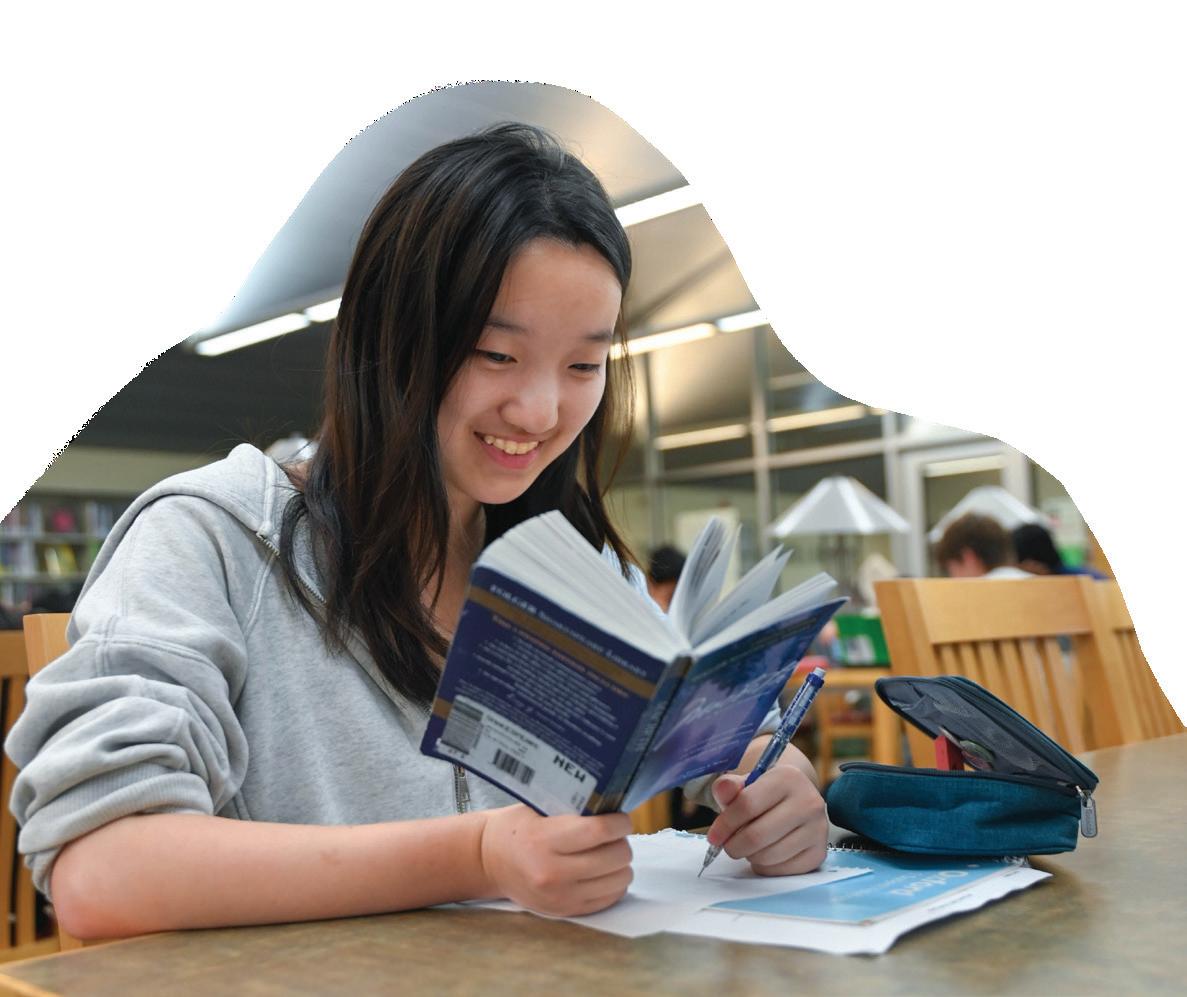

Christina Ruan
Isabel Yang
Ashley Zhou
The Winged Post is the official student newspaper of Harker’s upper school and is distributed free of cost to students every four to six weeks except vacations by the Journalism: Newspaper and Advanced Journalism: Newspaper courses at The Harker School, 500 Saratoga Ave., San Jose, California 95129.
We aim to publish balanced stories with professional standards while serving as a public forum for Harker students. All content decisions are made by student editors. Opinions and letters represent the viewpoints of the writers and do not necessarily reflect the opinions of The Winged Post, Harker board, administration, faculty or journalism advisers. Editorials represent the official opinions of The Winged Post editorial board. Letters to the Editor may be submitted to Manzanita 70 or emailed to harkeraq@ gmail.com and must be signed and legible. The staff reserves the right to edit letters to conform to Winged Post style, and letters will be published at the discretion of editorial staff. Baseless accusations or libelous statements will not be considered for publication.
NSPA Pacemaker Winner: 2024-25, 2019-20, 2017-18
NSPA Pacemaker Finalist: 2023-24, 2020-21, 2018-19, 2016-17
CSPA Gold Crowns: 2025, 2024, 2023, 2019, 2018, 2016

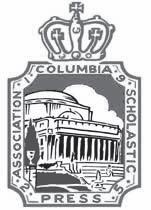
We’re all works in progress.
Even in skills we think we’ve mastered and in things we think we know, there are always moments that remind us just how much we still have to learn. For me, journalism has been my constant reminder that learning never really stops — every article I’ve written and every page I’ve designed has taught me something new.
When I first began reporting for Harker Journalism in my sophomore year, I approached my articles believing I understood the basics of journalistic writing from my Introduction to Journalism class. But seeing my drafts returned with comments and suggestions on my structure, concision, adherence to Associated Press style and more quickly humbled me.
Reading work by experienced staff members and professional journalists further made me realize how much I still needed to learn in order to craft compelling stories through my writing. No matter the article to which I was
process, while another may focus more on timed writings and place less weight on the final draft. In addition, English teachers face
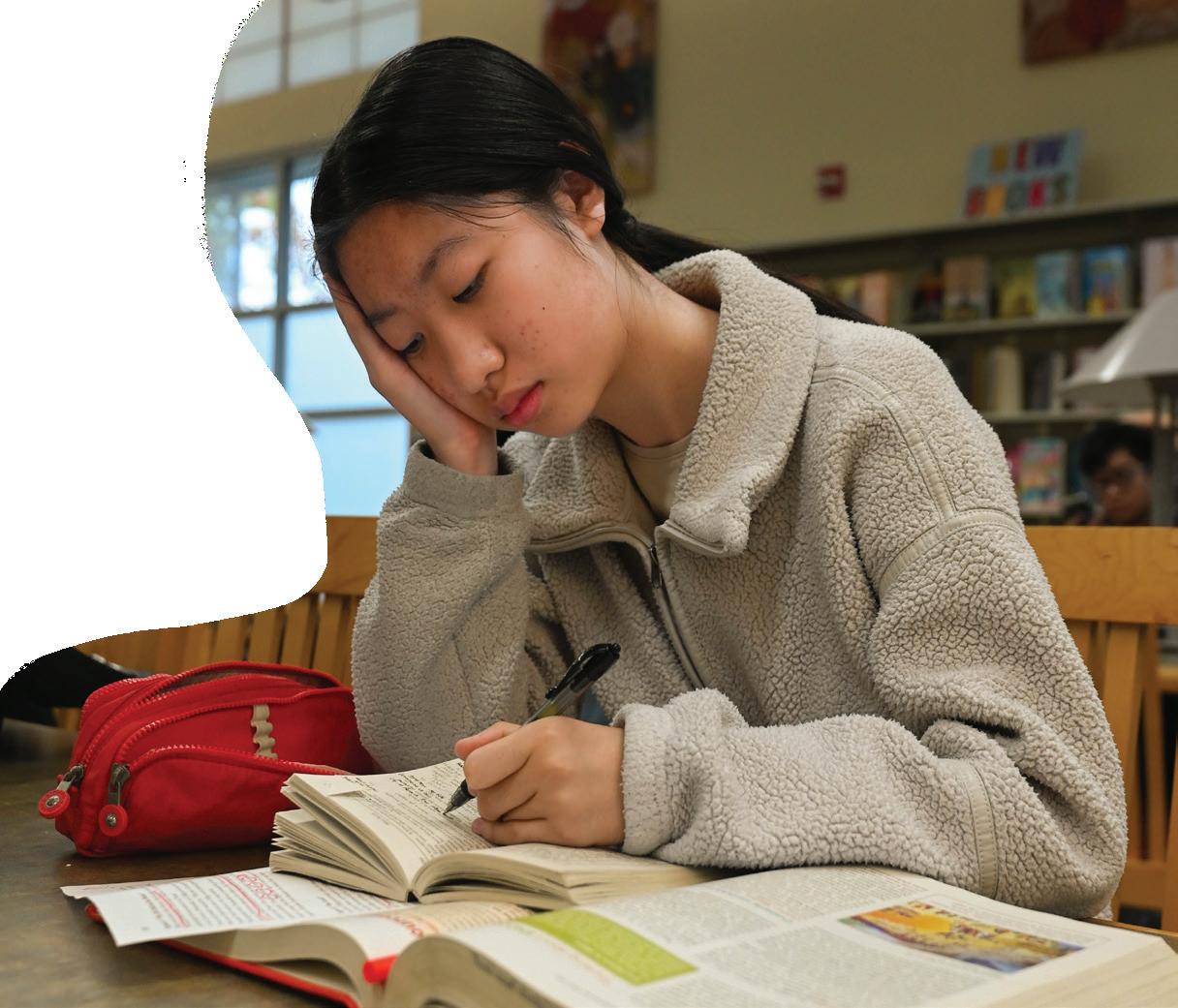
more difficulty in maintaining similar grade ranges. Unlike
Differences can inadvertently cause disparities in pacing and overall learning.
STEM courses, there is no correct answer or right way to write a paper so it’s impossible for two different teachers to read a paper through the same lens and evaluate it with identical standards. One way to reduce teaching differences without restricting teacher autonomy is the implementation of endof-semester or mid-semester feedback forms to gauge student progress and topic understanding. End-of-year forms, which teachers in most classes use, arrive too late:
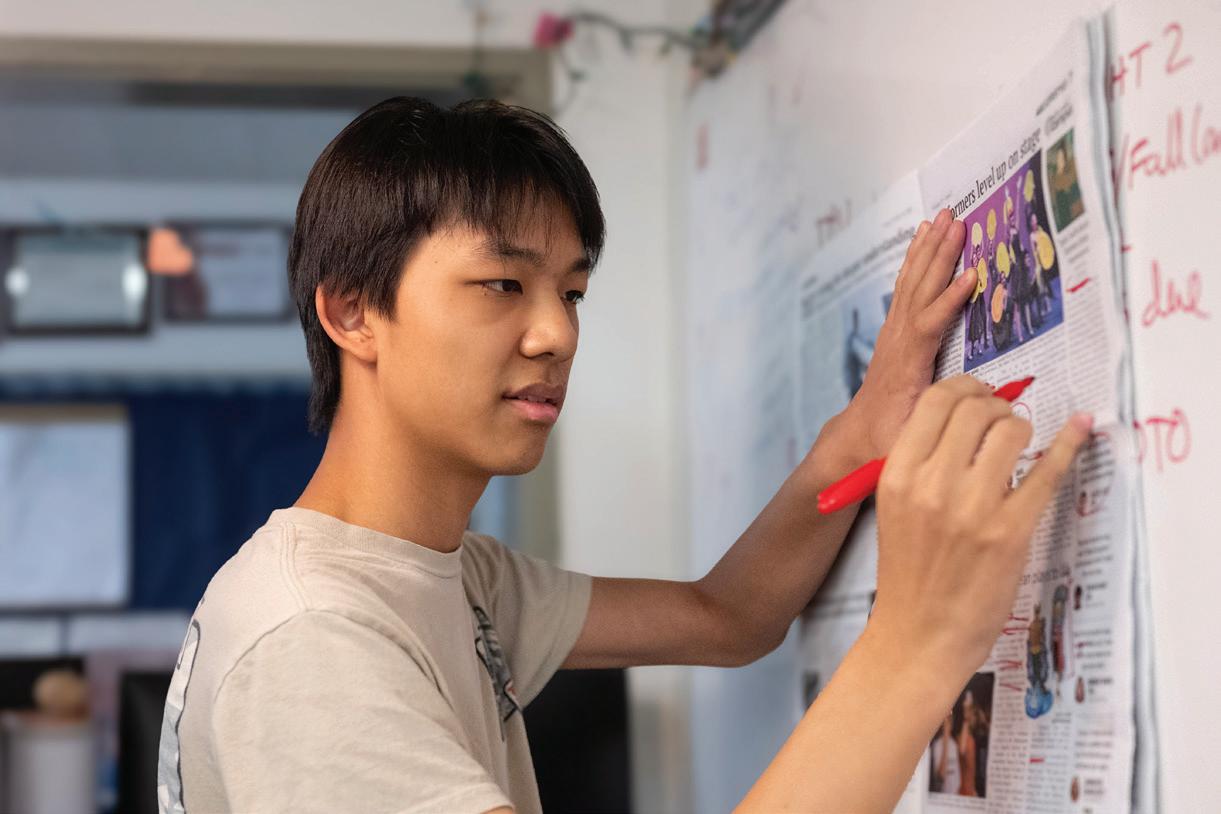
assigned, there would always be areas where I could improve in my writing.
I work with the other members of the Winged Post strategic team to design key pages of each issue. We are student leaders of this newspaper, yet we do not consider ourselves immune to criticism. We remain open to feedback from one another and from our adviser Whitney Huang throughout the design process.
In fact, I’m deeply grateful for their critiques of my work. None of us hesitate to give
honest feedback when it can lead to real improvement, and some of the most valuable advice I’ve received have come from their direct and candid criticisms. I’ve learned to take these critiques to heart. Facing the reality that we still have room for improvement in the skills we think we’ve mastered is where real growth happens.
I have approached this third issue by encouraging myself and editors to push beyond their comfort zones as they craft their pages, to experiment with ideas they
students have already finished the course and will not benefit from any of its resulting changes, which also reduces their motivation to offer meaningful feedback for future years.
Additionally, teachers should increase transparency in grading. While many teachers already compare class averages and grade distributions with colleagues, allowing them to benchmark their own grading practices, making these statistics available for students will encourage accountability and trust in the system. Clear rubrics and sample essays shared between classes can also help ensure that students have a proper understanding of the grading and are evaluated more objectively according to rubrics.
Standardization doesn’t mean restricting every teacher’s creativity or enforcing identical classrooms. It means guaranteeing that every student receives equal opportunities.
CORRECTIONS TO ISSUE 2
NEWS 4: “George Abbott” should be “Greg Abbott”
CORRECTIONS POLICY:
Our staff strives to represent our community fairly and conduct accurate, truthful storytelling. We list all errors of an issue, along with the page number of that error in the next issue’s corrections box. Feel free to provide feedback via the QR code to the right.

wouldn’t typically explore. We should always appreciate the steps we’ve taken that have led to our accomplishments, while also recognizing how much farther up the staircase goes. Whether we are a novice or an expert, striving for constant improvement, in spite of the additional effort and difficulty of accepting criticism, is an essential component of our personal growth.
So, as you read through this Winged Post issue, I hope it inspires you, the reader, to find an area in your own life where you consider yourself an expert, something you think you’ve mastered — and challenge yourself to reach the next level. Because, in the end — we are all still works in progress.

claire tian
AI models are more accurate than ever. We see fewer blatantly and hilariously incorrect responses to everyday queries, but that doesn’t mean we can trust large language models (LLMs) unilaterally.
Chatbots like ChatGPT, Gemini and Claude use statistical patterns learned from billions of texts to predict the next word they should say in a conversation with you. While the resulting language will be fluent and coherent, it is not always factually correct, as the most statistically probable continuation of a sentence may not be true. In AI terms, this tendency to produce plausible but incorrect statements is called “hallucination.”
Before accepting an LLM’s output as fact, you should consider whether an it’s equipped to answer your query. Obscure or expert-level information, original reasoning and time-sensitive information are probably poorly represented in language models’ training data sets.
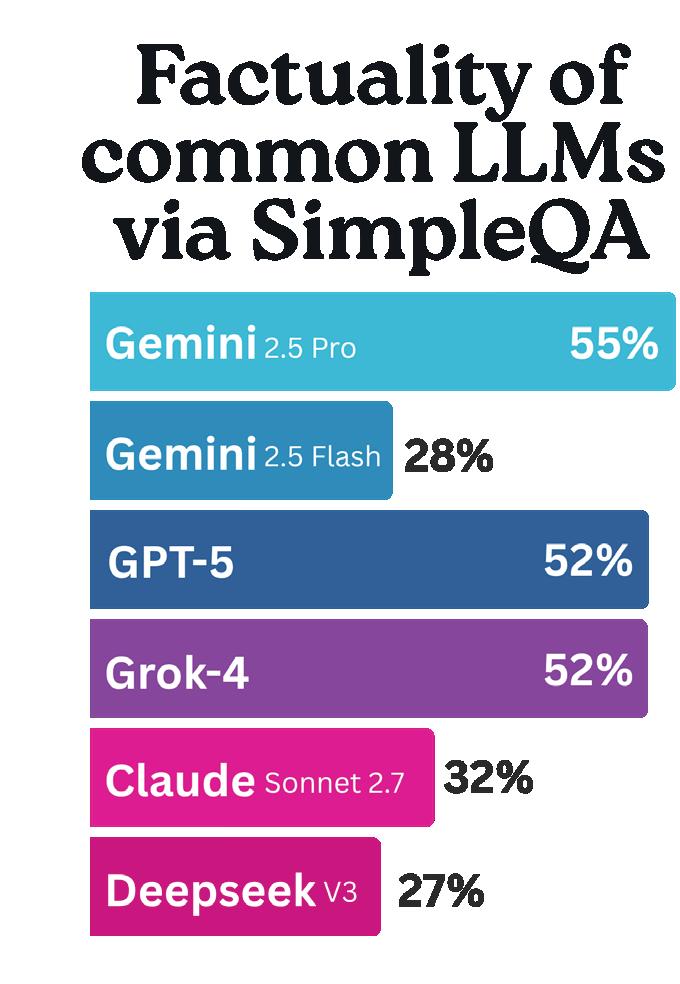
SOURCE: KAGGLE.COM, GOOGLE DEEPMIND
While wrong answers are dangerous, an even greater concern is that an LLM will always sound confident when giving them. If an LLM could tell you when it is not capable of producing a good answer, identifying misinformation would be much easier.
lum
Medical Club held their annual Evening of Medicine event, inviting 60 students to participate in anatomy table discussions, hands-on medical procedure practices and a speaker event from orthopedic surgery professor Derek Amanatullah, M.D., Ph.D in Nichols on Friday.
Students also practiced a heart dissection, which featured a handson exploration of the chambers and valves in a pig heart. Instructed by biology teacher and Medical Club adviser Matthew Harley, participants took turns cutting and probing organs, noting important structures like the coronary artery.
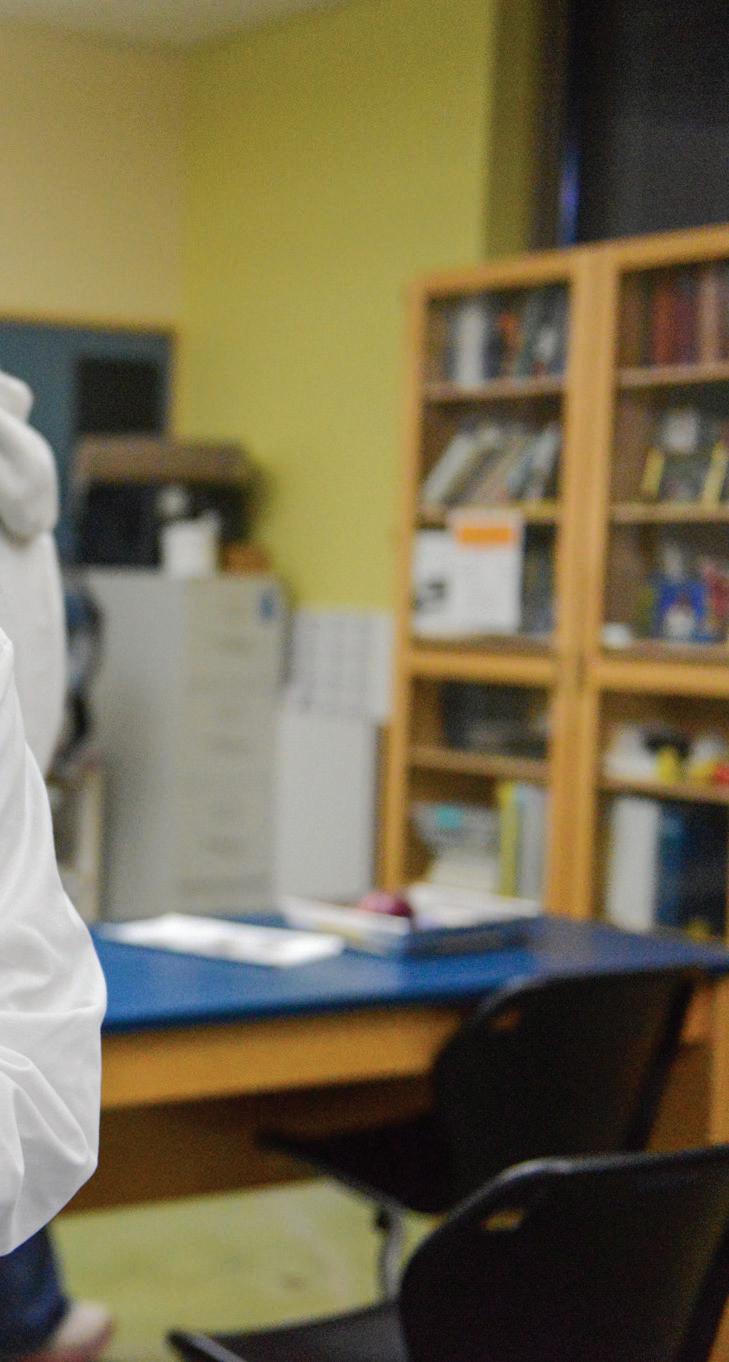
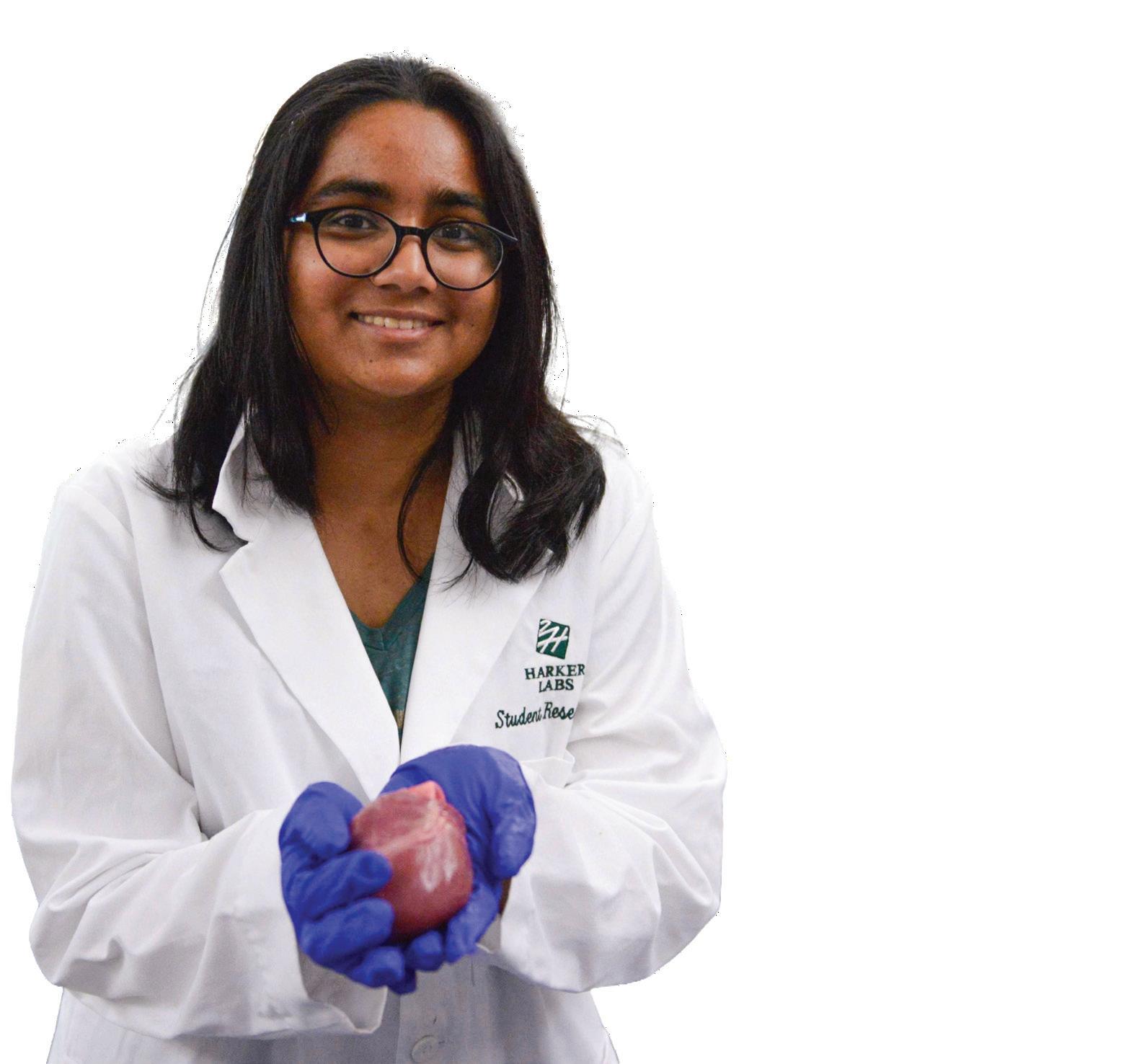
Unlike typical classroom dissections, which use preserved hearts, participants dissected fresh pig hearts.
“In eighth grade, we also did a heart dissection, but it wasn’t as bloody as this one — this one felt more like a real heart, which was really cool,” Kavya said. “It’s really cool that school [gets] to do this.”
Science Department Chair Anita Chetty showcased 3-dimensional models of the human body through Harker’s Anatomage table, one of the only anatomy tables in the nation owned by a high school. Chetty ran through muscle groups in a virtual human model nicknamed “Carl,” a death row prisoner who donated his body to science.
In the same discussion,
“If you’re convinced that medicine is the one thing for you, just do it. Who cares if it’s hard?
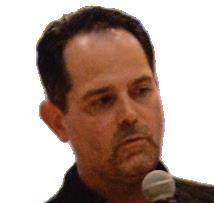
DEREK
AMANATULLAH
ORTHOPEDIC SURGEON
on an ectopic pregnancy case study and the valves of the heart.
Medical Club officers Riya Samuel (11), Nikita Jain (10) and

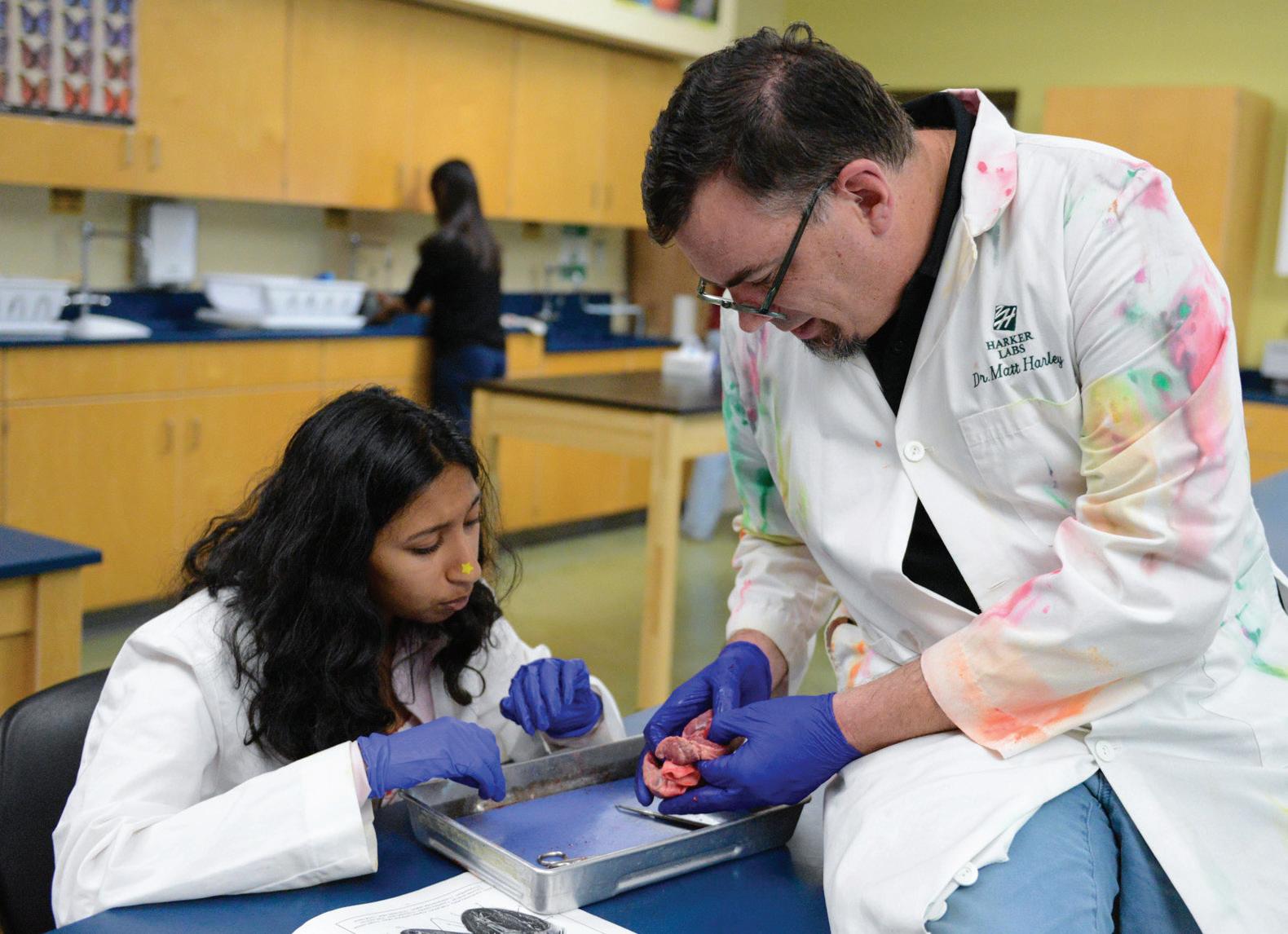
Bella Wu (10) led the banana peel suture activity, where students practiced the simple interrupted suture, a simple suturing technique featuring separated sutures, with forceps and surgical needles. The officers also demonstrated more advanced techniques like using a pair of forceps to make a neater knot.
“This event is really interesting because you look at those pictures in textbooks and you’re like, ‘OK, yeah, that’s how it looks,’” said sophomore Isabella Wong. “But knowing that what’s in the textbook is actually real and actually being able to see it is pretty cool.”
Students congregated in Nichols Auditorium to hear from Dr. Amanatullah. He spoke about his career as both
a researcher and orthopedic surgeon, emphasizing the importance of managing his time. Bringing up a photo of his daily schedule, he detailed the sacrifices he makes, comparing each new time commitment to a ball he has to juggle.
“If you have decisional regret, [medicine] is going to suck,” Dr. Amanatullah said. “But if you’re convinced that [medicine] is the one thing for you, it’s the most amazing thing ever. You just do it, and who cares if it’s hard? That’s why you’re here to figure it out.”
In a Q&A section after the presentation, students asked Dr. Amanatullah about his favorite surgeries, his daily life as a surgeon and what they could do to start their medical journey.
Visit harkeraquila.com for more.
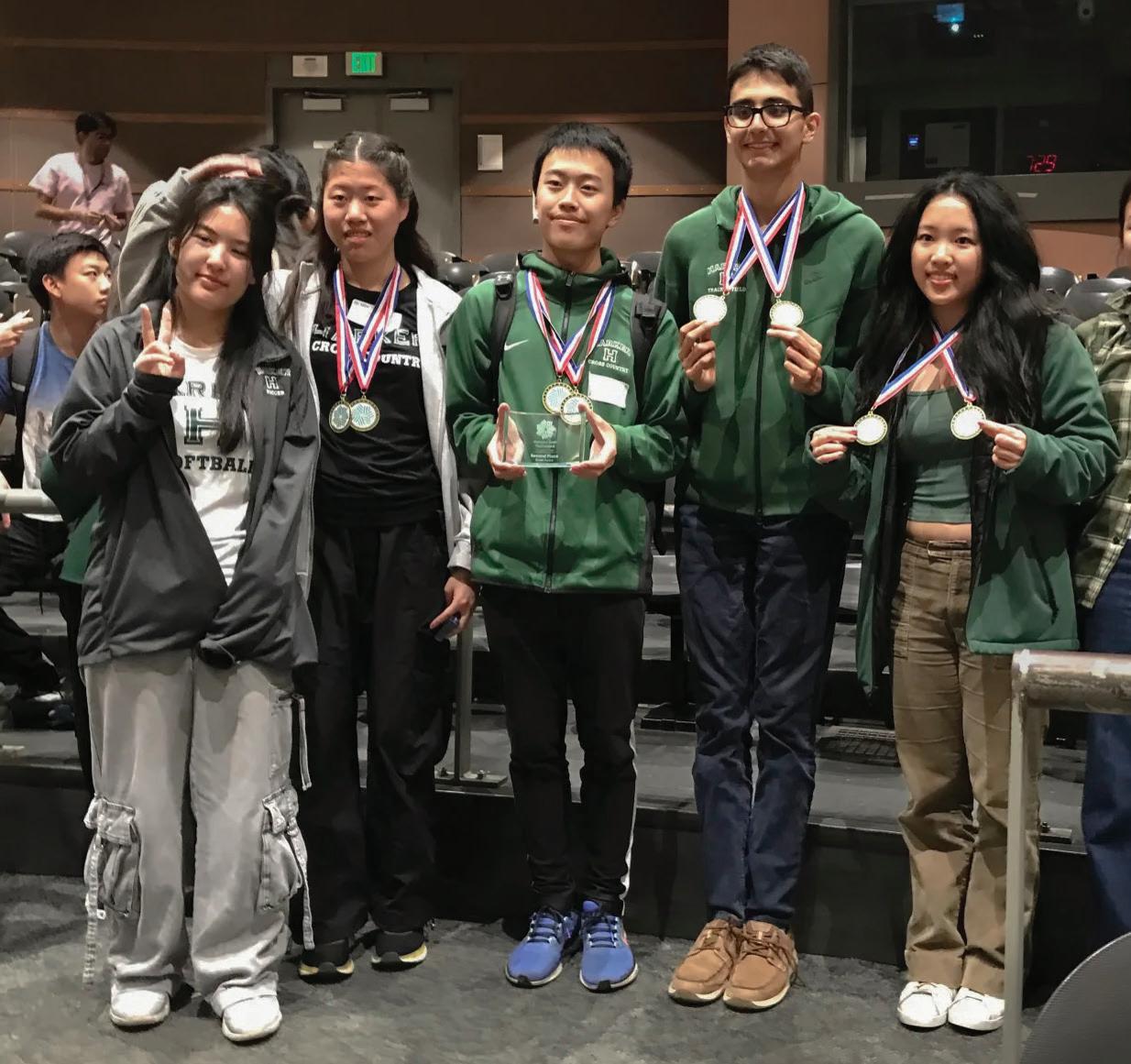
Liang, Lily Peng, and Elaine Xu. This is the first time since 2018 that any Harker team has achieved a top 10 finish at BMT.
“We were pretty shocked,” Math Club Co-President Jonathan Li said. “I wasn’t really expecting at all. I didn’t think we had any chance of placing, but somehow it happened. We were very surprised, but also obviously really happy.”
BMT comprises three rounds, each requiring a distinct set of skills. The Power Round, lasting 90 minutes, is a proofbased team round that delves into advanced topics not commonly found in high school contests. Teams are required to provide justification for answers, with the past two years’ topics being origami and graph theory proofs. Harker Omega earned second place in this round.
This overconfidence is an issue embedded in the way LLMs were trained, according to a recent OpenAI study. LLMs are typically evaluated and improved according to industry benchmarks, like curated sets of expert-level science and math questions. The study suggested that most of these evaluation methods and leaderboards incentivized LLMs to guess, or hallucinate, responses to challenging questions instead of being honest about not knowing the answer. “
Math Club achieved historic success at the Berkeley Math Tournament (BMT) on Nov. 9, where team Harker
The winning team consisted of juniors
I didn’t think we had any chance of placing, so we were very surprised, but also really happy.

JONATHAN LI (11) HARKER OMEGA MEMBER
“I got kind of mad because I was bashing this random geometry problem and could not figure it out,” said Rachel. “There were also a bunch of ‘67’ references for no reason!”
Each contestant also participated in the Individual Round, where they could choose between taking the General Test or two Focus Tests. The General Test included a variety of questions intended for those with less prior contest experience, while the Focus Tests allowed students to dive deeper into subjects like Algebra, Geometry, Discrete Mathematics, and Calculus. Sophomore Rachel Li participated in the General Test.


Coral reefs support 25% of marine life but currently face their largest bleaching event in history, marking the first time human-caused climate change has pushed an ecosystem to the point of no return.
With the increase of heat, even by a few degrees, coral undergoes bleaching when removing algae called zooxanthellae from their tissues. Thriving on a symbiotic relationship, these algae use photosynthesis to produce nutrients while offering corals their bright colors, so upon expelling the algae, the coral’s white limestone skeleton becomes visible.
“Corals aren’t like plants that can bounce back. Once damaged, they take years to recover.

OSKAR BAUMGARTE ’25 CORAL RESEARCHER
“Once corals start to bleach, the whole ecosystem is destroyed,” coral and marine biology researcher Oskar Baumgarte (’25) said. “Once damaged, corals take years to recover. With the coral that I sampled for my research, I cut small pieces of tissue out of it. It’s been a year and just now it’s fully recovered and growing bigger again.”
Seen as a climate change “tipping point,” researchers pinpoint that over 80% of coral reefs have been hit by extreme temperatures.
“Contrary to popular belief, corals are one of the most sensitive organisms in the
ocean, more sensitive than fish,” Oskar said. “I had this small reef tank when I was in middle school, and one time I washed one of the tools I was using with soap, but not all the soap came off of it. When I used the tool in the tank again, the corals all died within a couple weeks.”
When coral becomes bleached, it disrupts the rest of the ecosystem. As coral become less colorful, the brightly colored fish that use reefs to hide from predators are also threatened. In fact, global bleaching events have decreased the coloration of fish in reef ecosystems.
Senior Victoria Ma conducted research on marine biotoxins and simultaneously learned about marine life. She emphasized the significance of coral in various ecosystems.
“Coral reefs are one of the biodiversity hotspots on the entire planet, and they’re home to so many different species,” Victoria said. “Losing them would mean so many beautiful, colorful and diverse organisms losing their homes.”
reef organisms have yielded treatments for cancer, arthritis

and other diseases — we’re losing a pharmaceutical library before we’ve even read it.”
The decline of coral reefs also threatens human lives. Coral reefs serve as natural barriers that protect shorelines from erosion and storm surges, and their loss places millions of coastal residents at higher risk of flooding and property damage. They contribute $3.4 billion of value to the U.S. through fisheries, tourism and coastal protection according to AP Environmental Science teacher Jeff Sutton.
“Coral reefs provide protein for millions of people, support jobs in fishing and tourism industries and protect coastal infrastructure worth trillions,” Sutton said. “Additionally,

SOURCE: NOAA
Coral loss further affects the balance of marine chemistry. Healthy coral helps stabilize local pH levels and supports the organisms that depend on calcium carbonate to build their shells. When coral dies, however, their skeletal structures erode, reducing this buffering effect.
The large-scale bleaching and death of coral is one of many warning signs that the planet is under strain. While researchers race to restore coral through reef gardening, selective breeding and temperature monitoring, their efforts can only do so much without global change. Green Team Co-President Siddhartha Daswani (11) commented that the death of these corals

reflect a larger disregard for the environment.
“[The situation] is a symptom of the way that we approach the environment in the sense that we don’t have regard for these things until they’re gone,” Siddhartha said. “Even though we might not be directly impacting corals, there are still things that we do that hurt ecosystems everywhere, so we have to pay attention not just to what we’re directly impacting but also beyond that and what could be impacted.”
Reducing carbon emissions, supporting sustainable tourism and advocating for ocean conservation all play a part in reversing this decline. Sutton also cites choosing sustainable seafood and using reef-safe sunscreen as often overlooked ways to benefit the environment. Ultimately, the protection of our coral reef rests in our efforts toward sustainability.
“We need action at multiple scales — globally, nationally and locally. This is our challenge to solve.

JEFF SUTTON AP ENVIRONMENTAL SCIENCE TEACHER

“We need action at multiple scales — globally, nationally and locally,” Sutton said. “Time is critical. We’ve lost nearly half of the world’s coral reefs since 1950, but there is hope. This is our challenge to solve.”

emma li & lindsay li
Q: What is your research about?
A: “My research is about creating these workflows that essentially allow you to convert messy data, usually X, Y, Z positions of ocean particles, into a visualization so you can see how water and temperature move over time.”
Q: Why did you choose this topic?
A: “With climate change as such a large problem in our world, I wanted to focus on something that could track how it’s affecting our oceans. I love coral, everything that grows in the ocean and just spending time at the beach too. So this connects to my love for the sea as well.”
Q: What were some major challenges or setbacks?
A: “I was basically running into issues with my code every single day. I was learning a new programming language, file organization system and lab server I’d never used before. Sometimes it felt out of my control because everything was so new. Reaching out to other people for help always worked better.”
Q: What was your biggest takeaway from your research?
A: “I’ve always thought if you go into programming you need to be an engineer at a tech company like Apple or Google, but this showed me that you can use your technology skills in any field you want to create an impact in. For me, that’s the environment and the ocean.”
caden ruan & disha gupta
At the center of Paul Paik’s career is a simple motivation: to help other people. Teaching let him support students, but medicine offered him a more direct way to make a difference, something which now defines his daily work.
Dr. Paik is finishing up his gastroenterology and hepatology fellowship at the Keck Medicine of University of Southern California and will soon practice gastroenterology in Los Angeles. On a typical day, he works at the county hospital, threading cameras through a patient’s digestive tract, using dials to guide miniature tools that cut out polyps or open blocked esophagi.
Be surrounded by people who are curious about the world and interested in the sciences.

PAUL PAIK USC KECK LAB OF MEDICINE FELLOW
“It’s honestly really fun,” Dr. Paik said. “You’re doing these tiny procedures, and sometimes the next time you see the patient they’ll say, ‘I can eat and drink fine now.’ Knowing you fixed that problem is gratifying.”
Dr. Paik’s interest in science began at Harker in Anita
Wu’s AP Chemistry class, which helped him see STEM as a viable career path. She inspired him to tutor high school students in San Diego after graduating.
“Our tutoring extended beyond just coursework,” Dr. Paik said. “Math and sciences are definitely the weak points of most of the country’s schools, and some people are very fortunate to have that as a strong suit. You kind of take it for granted, but then you work with these students realize, ‘OK, I guess I have some skills that I can really help apply and use to improve their lives.’”
While assisting others in developing their skills, Dr. Paik continued honing his own through university wetlab research. He explored therapeutic approaches for Huntington’s disease and then spent a year in Baltimore at the National Institutes of Health, where his lab developed chemical compounds reducing the addictive properties of drugs like cocaine.
“Getting to see the early stages of what could potentially be a therapeutic for humans was incredible,” Dr. Paik said. “I could see the results at this very basic science level and think maybe decades down the line it could help with addiction to substances. Baltimore is unfortunately pretty renowned for having a significant drug issue, and I would see it on the street and on the bus every day
After graduating from Cornell, Dr. Paik remained at NewYork-Presbyterian for an internal medicine residency. He recalls working close to 80hour weeks, trying to balance the intensity of the hospital with his personal life. The pace left him drained: Dr. Paik wasn’t sure whether to continue with another round of training or step away.
“I was so exhausted during internal medicine residency,” Dr. Paik said. “Even though it’s only three years, and it’s one of the shortest residencies, it still felt hard to see the end of the tunnel at times.”
With the uncertainty
SMILING BIG (LEFT) Paul Paik enjoys a plate of sushi during his Japan vacation, exploring the country’s food and culture. CONFERENCE VISIT (LEFT) Dr. Paik poses in front of a conference sign in Boston.
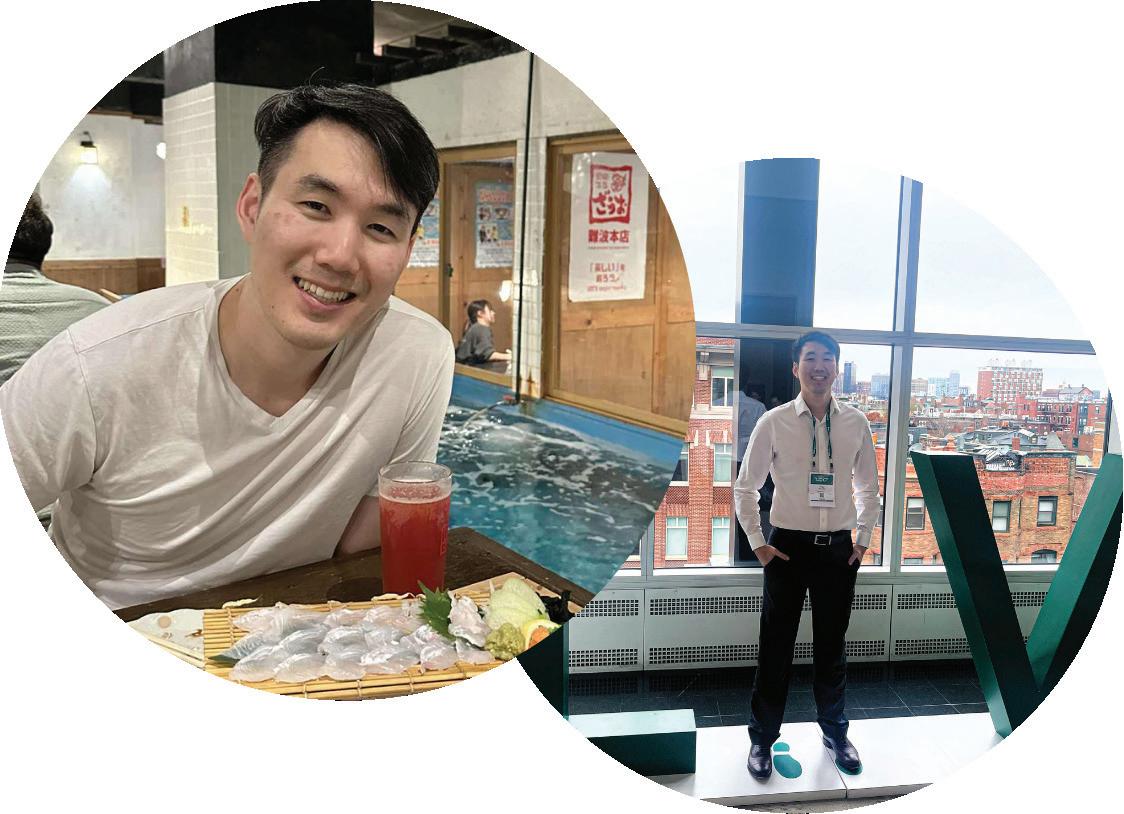
on the support of those around him, especially his wife, who encouraged him to pursue the specialty he felt happy with. Choosing to continue led him to USC for a gastroenterology fellowship, which gave him the space to think about the kind of research he hopes to pursue once he begins practicing independently.
“I’ve done clinical research during residency and fellowship, and I haven’t done any in gastric cancer or H. pylori yet,” Dr. Paik said. “H. pylori is very common in a lot of Asian groups, and seeing it at my county hospital has gotten me interested in it. In
LA’s sizable Korean population, there’s an opportunity to do some work with it, and I’m pretty excited about that.”
Looking back, Dr. Paik credits the people around him, mentors, classmates and colleagues, for helping him stay motivated through every step in his path. Being around others who were genuinely interested in science helped sustain his own curiosity.
“Definitely be surrounded by people who are curious about the world and interested in the sciences,” Dr. Paik said. “It helps you hold onto your own curiosity and keeps you going in the field and making a career out of it.”
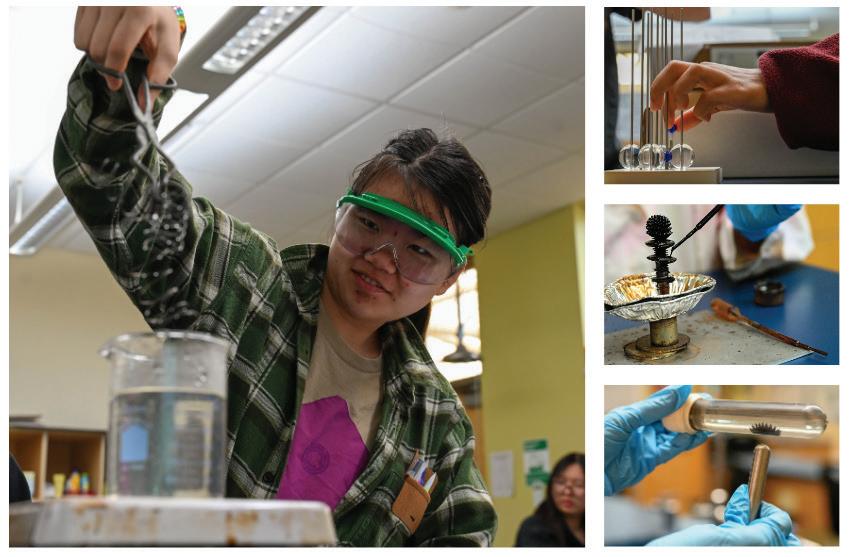
NITINOL WIRES (LEFT) Sylvia Chen (11) watches deformed nitinol wires return to their original shape. ATOMIC STRUCTURE (TOP RIGHT) A student uses marbles and metal rods to represent atoms and visualize how they connect. FERROFLUIDS (MIDDLE RIGHT) A student manipulates ferrofluids using a dropper as the liquid forms spikes along a magnetic field. MAGNETIC FIELD (BOTTOM RIGHT) A student holds a magnet up to a sealed tube of ferrofluids, showing how the particles align with the field.
lily shi & william jiang
A laser penetrates through a flask of nanogold solution, casting a bright red line that traces the laser’s path through the fluid due to scattering from
colloidal particles in the fluid.
The same principles explain everyday phenomena, from why the sky appears blue to how smoke makes light rays visible at concerts.
“In nanoscience, you learn what’s happening at the nano
level, but it’s usually hard to visualize like you would in the macro world,” nanoscience student Ethan Lei (12) said. “But making the nanogold was fun because when you add HCl, you can see the color change from red to blue and you know why.
You can see that when you shine a laser through the nanogold solution, it’s different from when you shine a laser through a red food coloring solution.”
Created by chemistry teacher Mala Raghavan, the elective centers on nanoscience: the study of materials at the “nano” scale, between one and 100 nanometers. The course is driven by hands-on labs, like the nanogold lab, where students learn concepts by working with nano-sized materials.
“This is such a scienceheavy school, and kids have taken every possible science class,” Dr. Raghavan said. “For the seniors, nanoscience is a perfect combination of all their knowledge to understand what’s really happening in nanoscience. It has all these weird, funky labs that you can do and explain the concepts of these things.”
Dr. Raghavan began teaching the class in 2015, motivated by the popularity of nanoscience at the time. She wanted students to understand how breakthroughs at the nanoscale shape the innovations of the modern world.
“The applications of nanoscience are enormous — it’s basically life-changing,” Dr.
Raghavan said. “AI would not have been possible if it wasn’t for nanotechnology. Computers are much better now because of nanotechnology, and the same thing with mRNA vaccines, CRISPR and all of these techniques that are learning how to manipulate things that are smaller and smaller scale and control atoms.”
Beyond the nanogold lab, students conduct more experiments to see how nanoscale principles play out in real time.
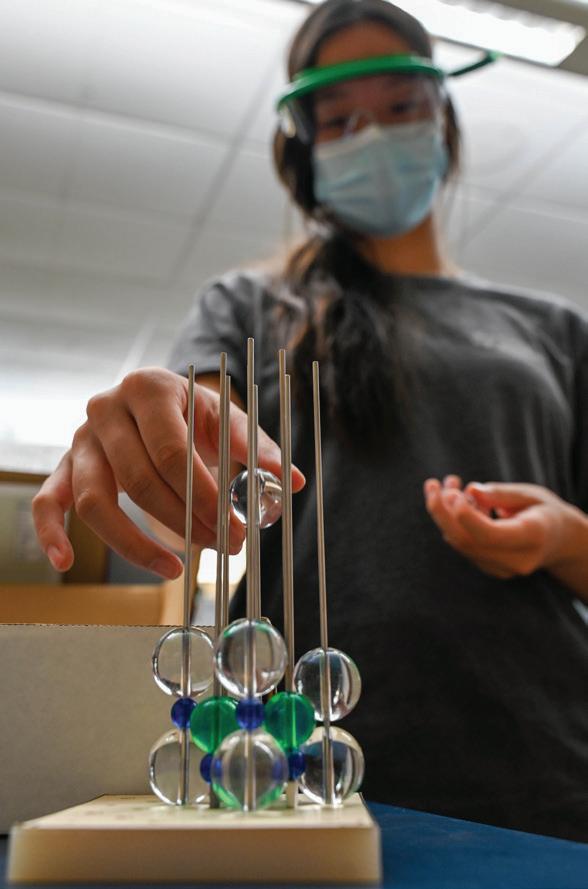
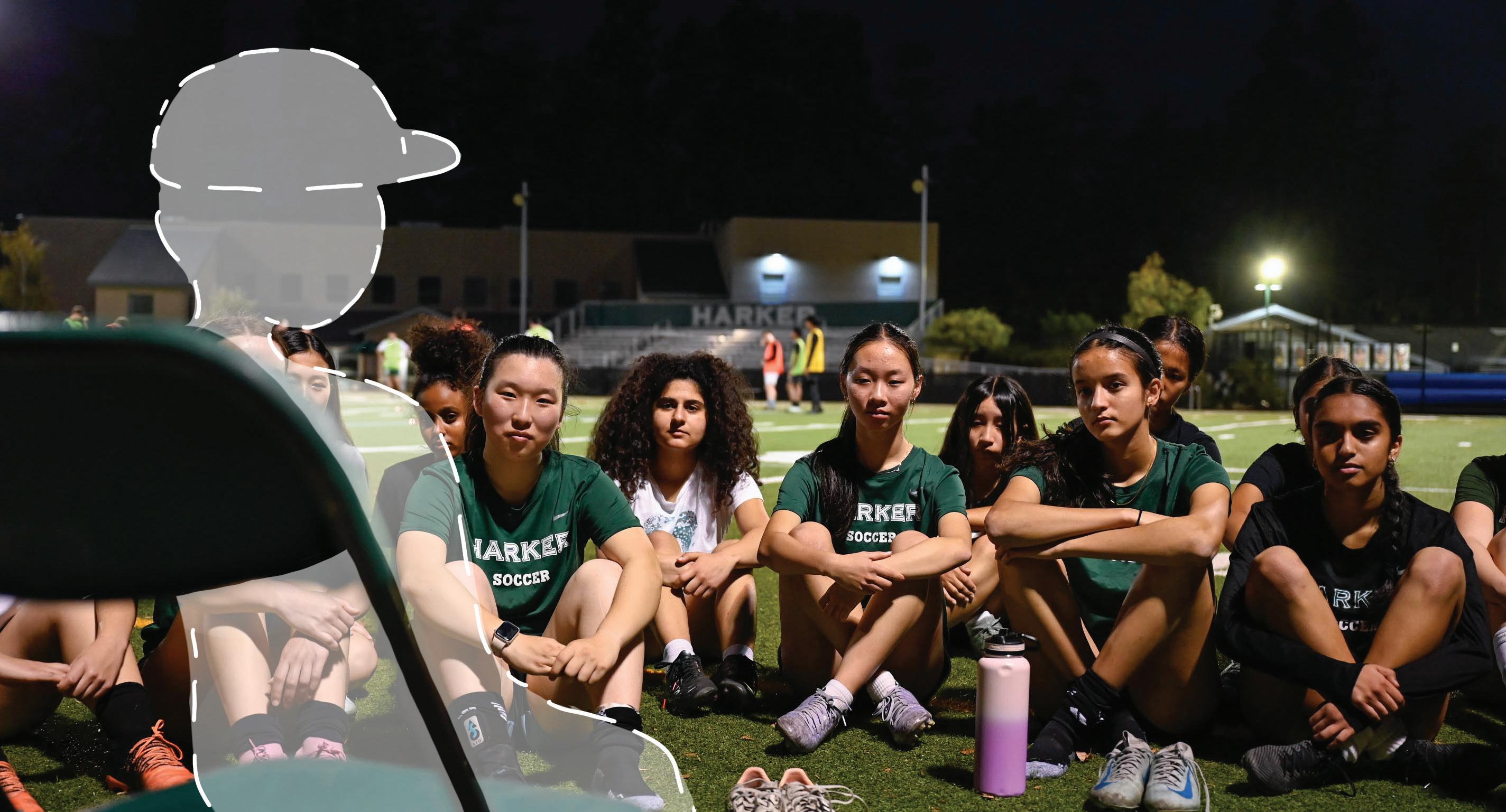
COACHING CONFUSION
Some sports teams like varsity boys and girls soccer have experienced uncertainty after multiple coaching changes in their recent years.
The personnel adjustments have affected team culture and bonding as well as performance on the field, which could have led to diminishing roster numbers.
When varsity girls soccer defender
Audrey Yang (12) stepped onto the field for her first practice this season, many aspects of the game felt familiar: the bonds with teammates, her pregame rituals and the drive to win. But the new voices calling out from the sidelines and foreign warm-up drills marked a shift from previous seasons.
Audrey noted how frequent coaching changes have forced players to constantly adapt to new systems and expectations.
“Switching a head coach every single year can be really hard because every single coach has a different perspective of playing,” Audrey said. “I’ve had to adjust to each coach’s liking. Our coach freshman year was more tough because I had to run more, but then last year the defenders didn’t have to work as
much because the emphasis was more on the midfielders.”
Over her four years on the team, four different head coaches have been in charge of varsity girls soccer. Other teams, including football and cross country, have also experienced high rates of coach turnover.
This year, former assistant varsity girls soccer coach Taylor Ortiz stepped up to manage the team as head coach. She explained how constant turnovers in leadership have impacted not only performance but also interest in the sport in general.
“That’s a huge explanation of why our numbers are so low,” Ortiz said. “If you don’t have consistency in your coaching staff, that’s not going to make you want to come out and play, and dedicate your time to a team where even the coaches aren’t sticking around. It’s not necessarily that the coaches weren’t committed, but they weren’t committed for the
Multisport athletes balance transitions, gain versatility
said. “The swimming muscles and jumping muscles are different.
When the final whistle blows for one sport, multisport athletes are already gearing up for the next season. Moving from the pool to the field and the court to the track, they must learn to develop not just physical endurance but mental fortitude.
Each sport demands distinct types of athleticism, requiring athletes to adapt quickly between seasons.
Junior David Tang plays water polo in the fall and volleyball in the spring, with only the winter season to rest. This transition from water polo to volleyball requires a change in mindset — first reading opponents’ moves underwater to anticipating sets and spikes on court.
“Each time I play volleyball or go back to water polo, my muscles always feel sore,” David
But in general, athleticism has helped with cardio.”
Regardless of the setting, these transitions sharpen adaptability and growth. David always trains with an eye for improvement.
For sophomore Omya Vidyarthi, who does track, rowing and tennis, switching between sports also means adjusting to different team dynamics and skills.
“Tennis has been a great experience,” Omya said.
“I’ve gotten to know a lot of upperclassmen through it, and I’ve made great memories. Track is more individual, but I’ve made close friends. Because there are not too many jumpers, it is a very tight community. For rowing, I have gotten to know a lot of people from other schools that I do not interact with as much.”
period of time needed to really engage and sustain the players we have.”
“Switching a head coach is really hard. Every single coach has a different perspective of playing.
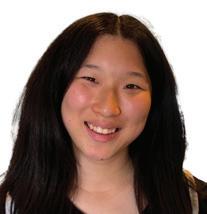
AUDREY YANG (12)
VARSITY GIRLS SOCCER
”Transitioning to new leadership undermines existing chemistry and disrupts the sense of stability essential for a team’s growth.
Varsity cross country captain Ava Alvarez (11) described how her team had to build trust and adapt to new routines after last year’s three
coaches were replaced with four new staff members.
“It was definitely a little rough at the beginning because last season we really solidified our bond as a team, especially with our coach,” Ava said.
“That’s the closest we’ve ever felt to our coaches, but then all of them left and moved away, so it was an entirely new coaching system. At first it was definitely hard for us to accept that our coaches were gone and totally accept a new style of coaching, but I think our team handled it really well.”
As players carry forward team routines under new staff, they take on greater responsibility, maintaining culture and guiding their peers. Ava expressed how experienced athletes must step into leadership roles to support their coaches who are still learning the program.
“The coaches are entirely new to Harker as well, so they had to get used to the Harker
culture,” Ava said. “The team captains have to become more independent and take on more of a role not only leading our team but also helping the coaches get accustomed. We had to tell them what we usually do during practices and races, for example.”
Student athletes have also found ways to continue growing amid the changes. Varsity boys soccer forward Vinayak Sinha (12) emphasized how, despite playing under three different coaches in four years, the team’s bond and love of the game allowed them to keep improving each year.
“Even when coaches change, the passion for soccer is constant,” Vinayak said. “Everybody on the team just wants to play, so we adapt to what the coach wants, and the coach adapts to our methods too. We compromise and find the middle path.
Visit harkeraquila.com for more.

Multisport athletes often balance overlapping practices and games throughout the year, making athletics a nearconstant responsibility.
Junior Grace Fu plays softball and archery, two sports that share the spring season. She explained that she stays on top of schoolwork by taking advantage of every free moment.
“Spring season is rough,” Grace said. “I have my finals and all my APs, so it definitely forces me to be more efficient with my time. When softball season rolls around, I’m forced to not spend as much time on my phone and to be at my most efficient.”
Many multisport athletes find that each sport offers a unique spot, whether it’s
productivity, focus or mentorship. For Omya, that lesson comes through training alongside more experienced teammates.
“Playing with upperclass teammates really made me look up to them,” Omya said. “Especially for track, I would say the upperclassmen step up to a coaching type of role and help fix different forms.”


Students and faculty share league strategies
eva cheng & lily shi
With the 2025 NFL season ongoing, competition is extending to Harker’s own fantasy football leagues, where competitiors battle it out week by week. Here’s what some fantasy players have to say!
I like the strategy that goes into it. Sometimes, you even have to take into account the emotional factors of players.”

ISHAAN DHILLONPATEL (10)
FANTASY FOOTBALL COMPETITOR
“My strategy is not about knowing the players but who I like to watch and honestly, what their name sounds like.”

KELLY HORAN
FANTASY FOOTBALL COMPETITOR “
You don’t need to know everything about every player in order to have some fun with your friends.”

KALLIE WANG (12)
FANTASY FOOTBALL COMPETITOR
girls volleyball varsity: 15-12
junior varsity: 16-4
frosh/soph: 9-11
football varsity: 3-1
girls water polo varsity: 15-12
boys water polo varsity: 18-8
junior varsity: 1-15
girls tennis varsity: 11-2
girls golf varsity: 16-0
cross country
varsity records:
girls: 19:36.8 - Sophie Shen (9)
boys: 15:59.2 - Axel Szolusha (11)
junior varsity records:
girls: 23:40.6 - Aahana Sharma (10)
boys 20:48.5 - Tavish Yergera (9)
When Jillian Chen (10) steps onto the court, the rest of the world fades away.
The internal pressure to live up to expectations and external roar of the crowd disappears, narrowing to the squeak of sneakers and echo of the basketball. She’s focusing on her movements, chasing the next play, the next possession. That committed mindset has come to define her as a player.
“Basketball has really formulated my ‘get it back’ mindset,” Jillian said. “You don’t have time to think — every time I miss a shot, I have to go get my rebound. Every time I lose the ball, I have to get it back.”
Yet, her resilient attitude did not develop overnight.
Jillian’s basketball journey began in fourth grade, when she would spend hours playing pickup games during recess with friends. Before long, the sport made Jillian feel like she belonged as she worked together with her team toward a common goal.
“Basketball is physical in a way that no other sports are,” Jillian said. “Everyone’s so competitive that it really brings you into a team more. When you go through hardships together, it brings you closer than any other friendships.”
In fourth grade, Jillian qualified for the Harker travel team, and by seventh grade, she began playing for club team San Jose Ninjas. This year, she also started competing for Fever Basketball AAU, a Cal Stormaffiliated club outside of school that plays in the selective Nike Elite Youth Champions League.
Jillian’s skill led to her being selected for both the 2024 and 2025 North-South League, a tournament showcasing the top 20 high school Asian basketball players from California. She was exposed to new levels of competition that allowed her to represent her community.
Teammate Finley Ho (11) has played alongside Jillian on the Harker team and the same club team since fourth grade and noticed how Jillian’s confidence has grown. She used to place pressure on herself whenever she made mistakes, but now she does not allow them to affect her.
“When I’m on the court with her, it feels like she is in control of the game,” Finley said. “She always brings up the energy or settles it when we’re up. She controls the flow of the game, and even though she was just a freshman last year, her presence on the court was really big.”
Professional players Paige Bueckers, with her support for her teammates, and Kaitlyn Chen, who serves as a role model for Asian Americans, have inspired Jillian to push her limits and develop leadership in the sport.
Now a point guard on the varsity girls basketball team, Jillian serves as a pacesetter.
“Basketball’s taught me how to be a leader and how to make my voice heard,” Jillian said. “On the basketball court, there’s so much noise, so many distractions — I know not only to be loud with my voice but also how to be efficient with my words. It’s not just
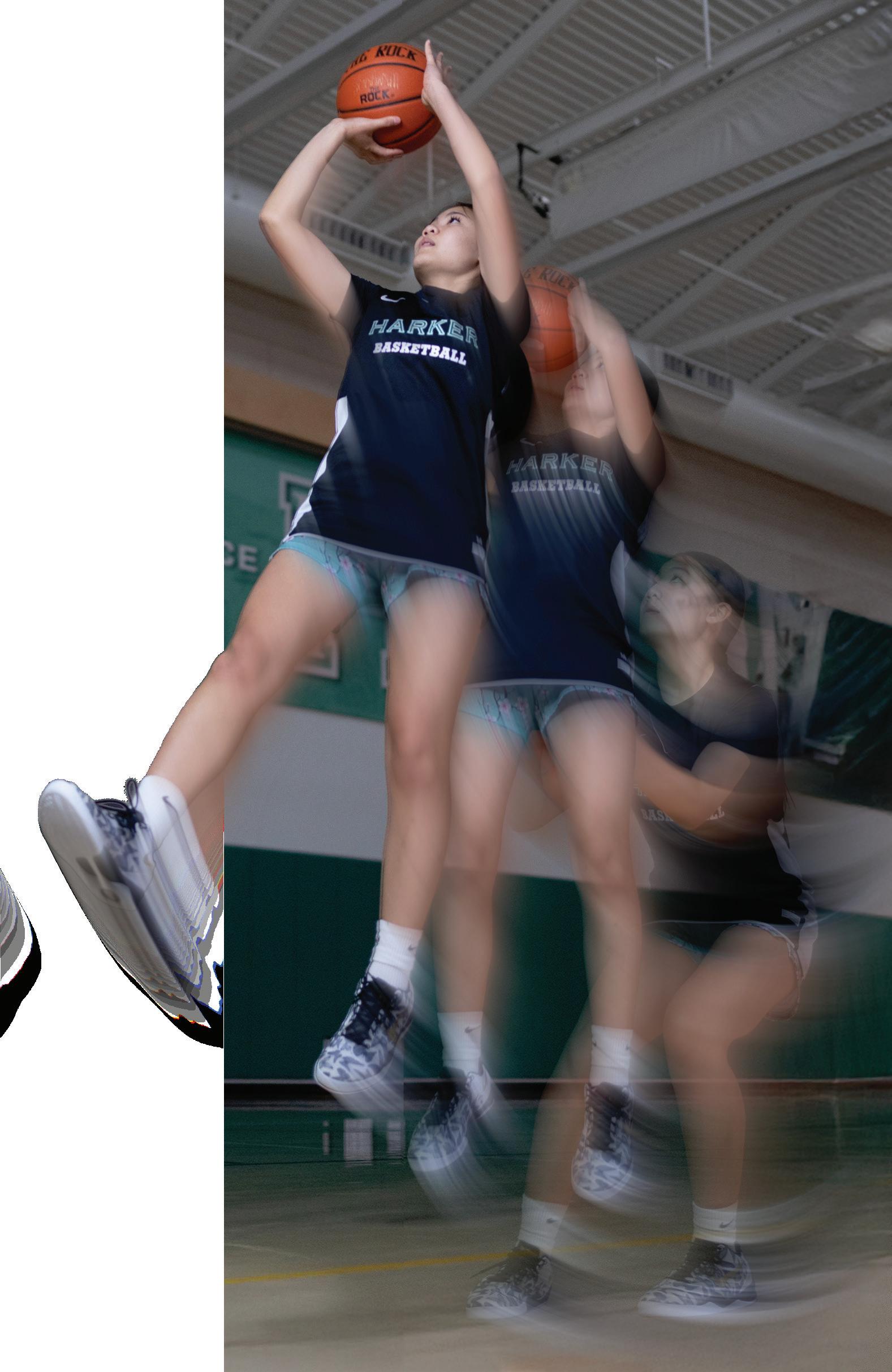
leadership verbally, but also leading by example. I can’t be telling people to do something if I’m not doing it myself. Truly,
basketball is the thing that has helped me the most in being who I am today.” Visit harkeraquila.com for more.

kotbagi & cynthia xie
University of Tennessee supporters tore down their stadium’s goal posts after upsetting the University of Alabama’s football team in a consequential matchup in the Southeastern Conference in 2024. The extreme celebration that resulted from this matchup comes in the context of decades of rivalry, and the heightened excitement shown by supporters exemplifies a key difference between the fan experiences at the collegiate and professional levels, even though the sports they watch are fundamentally the same.
University of Notre Dame alumnus and longtime Fighting Irish fan Byron Stevens expressed that, while fans of pro teams are often highly loyal, college fandom tends to be more intense.
“People are generally attached to college sports because they’re an alum of that school,” Stevens said. “So it’s much more part of their identity and their personal experience, and it can be very strong and deep for that reason.”
However, the broad appeal of mainstream sports franchises means that they’re able to accumulate millions of fans across the world.
Sophomore Anusha Saha, who primarily follows teams in the NFL and NBA, noted that the accessibility of content from those leagues elevates them above college sports in the popular consciousness.
“The play in pro leagues is of a much higher caliber, so it’s usually more fun to watch,” Anusha said. “The NFL and
NBA also get a lot more media coverage than colleges. The national deals that the stronger conferences have with media networks mean that they now get a lot more nationally televised games, but when I think of a football weekend, I think of NFL Sunday, not college football Saturday.”
Sports fan Hanwen Cui (10) added that level of enthusiasm and fanbase size are inversely related when comparing college and pro sports. The same loyalty to one’s alma mater that makes college fans so dedicated can also contribute to university teams being less engaging to outsiders.
“The pro sports fan base is larger, but college fandom is a lot crazier,” Hanwen said. “You see passion in pro sports too, but it doesn’t rise to the levels seen in college. Because you have that tangible connection, you feel a lot more passionate about that team versus if a pro team is just in your area, so you really do feel more spirited about college sports.”
Varsity boys and girls water polo dominate in the pool
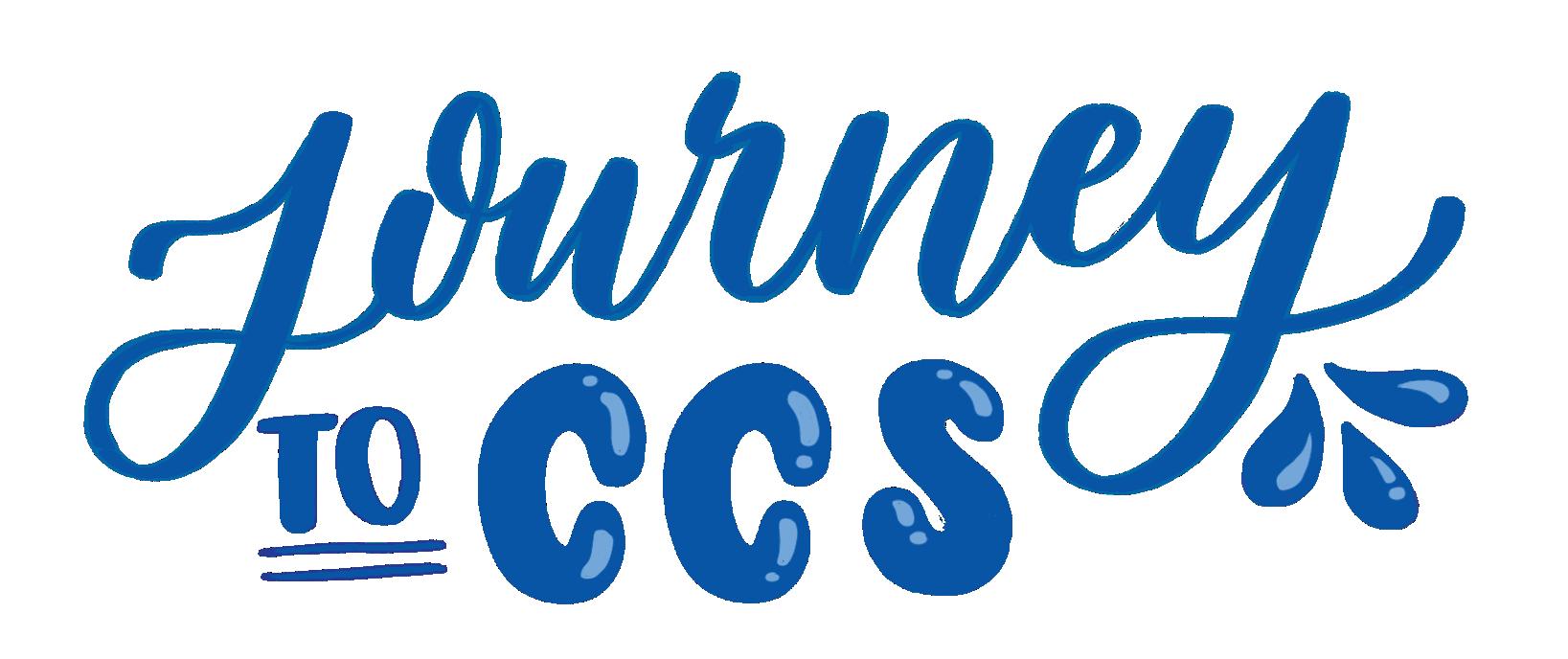
lily peng & charlene li
After riding the wave of victories and losses from league games, varsity boys and girls water polo teams embarked on another journey through Central Coast Section playoffs. Months of training added up to these key games.
“We’ve been dealing with small numbers for a while, so we’ve had to build stronger endurance and get closer as a team.

ELAINE XIA (11)
VARSITY GIRLS WATER POLO PLAYER
Leading up to their second CCS finals in the team’s history, the boys secured the first seed in the CCS Division II bracket. They conquered Willow Glen in quarterfinals 15-4 and emerged victorious 11-8 in semifinals against Stevenson. Their season culminated in a CCS final versus Leland High School with a final score of 9-12 on Nov. 15.
The girls team also made a run in CCS Division II with the sixth seed, playing St. Ignatius in the quarterfinal match on Nov. 8. Despite going in with an injured goalie and fewer substitutes than their opponents, the team fought with perseverance but ultimatedly yielded 4-14.
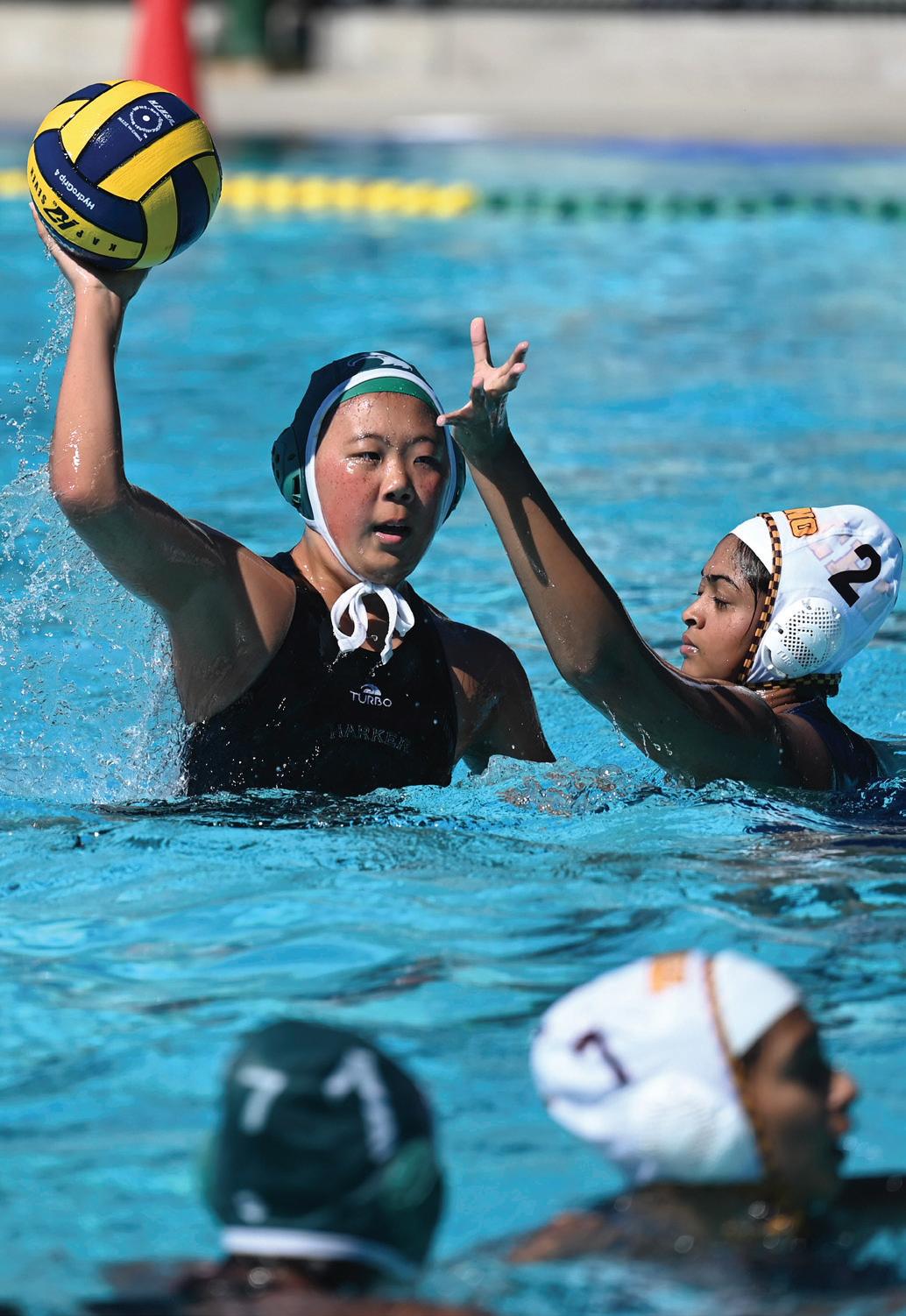
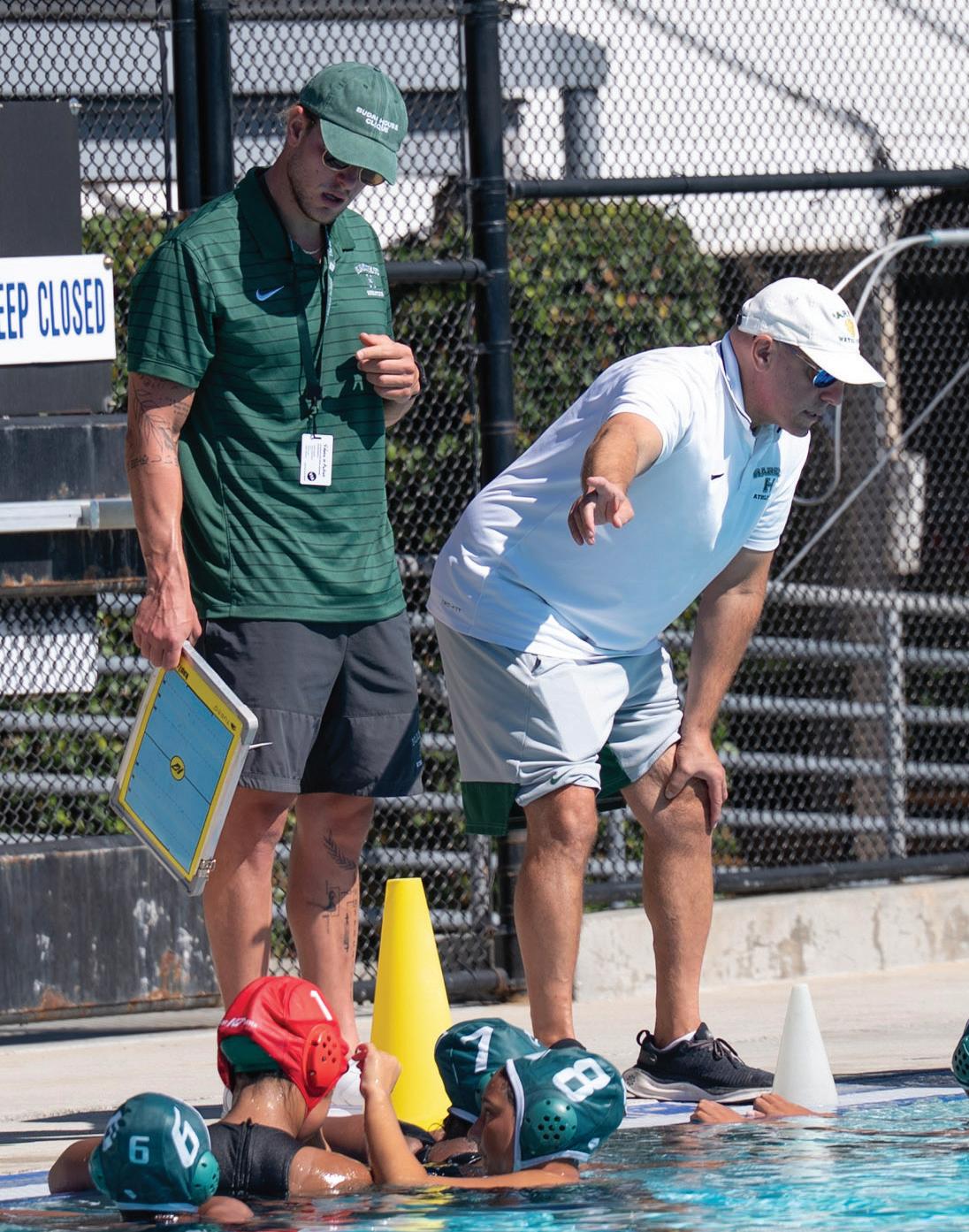
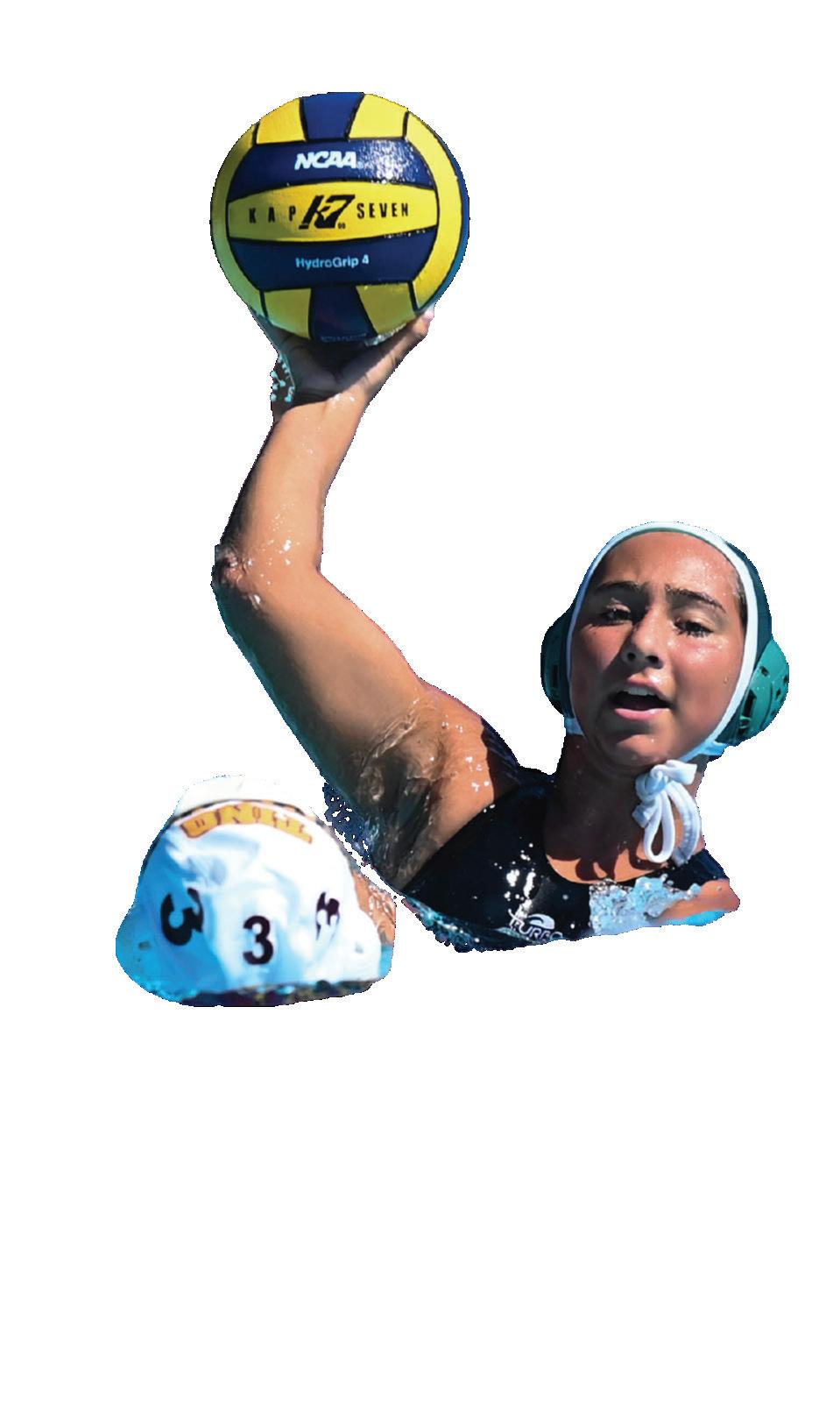

WINDING UP (LEFT)
Varsity girls water polo field player Alana Brill (12) prepares to shoot a goal. After injuries afflicted the team, she stepped up to secure a postseason berth against third seed St. Ignatius. MAINTAINING THE POSESSION (BELOW) Varsity boys water polo field player Ian Cheline (11) leans back to protect the ball from a defender. He holds Harker’s record of 147 goals and is also first in goals scored in CCS. TEAM TOGETHER (LEFT BELOW) Varsity girls water polo team gathers in a huddle during their senior night game. The team celebrated their three seniors in a ceremony after they competed in their match.
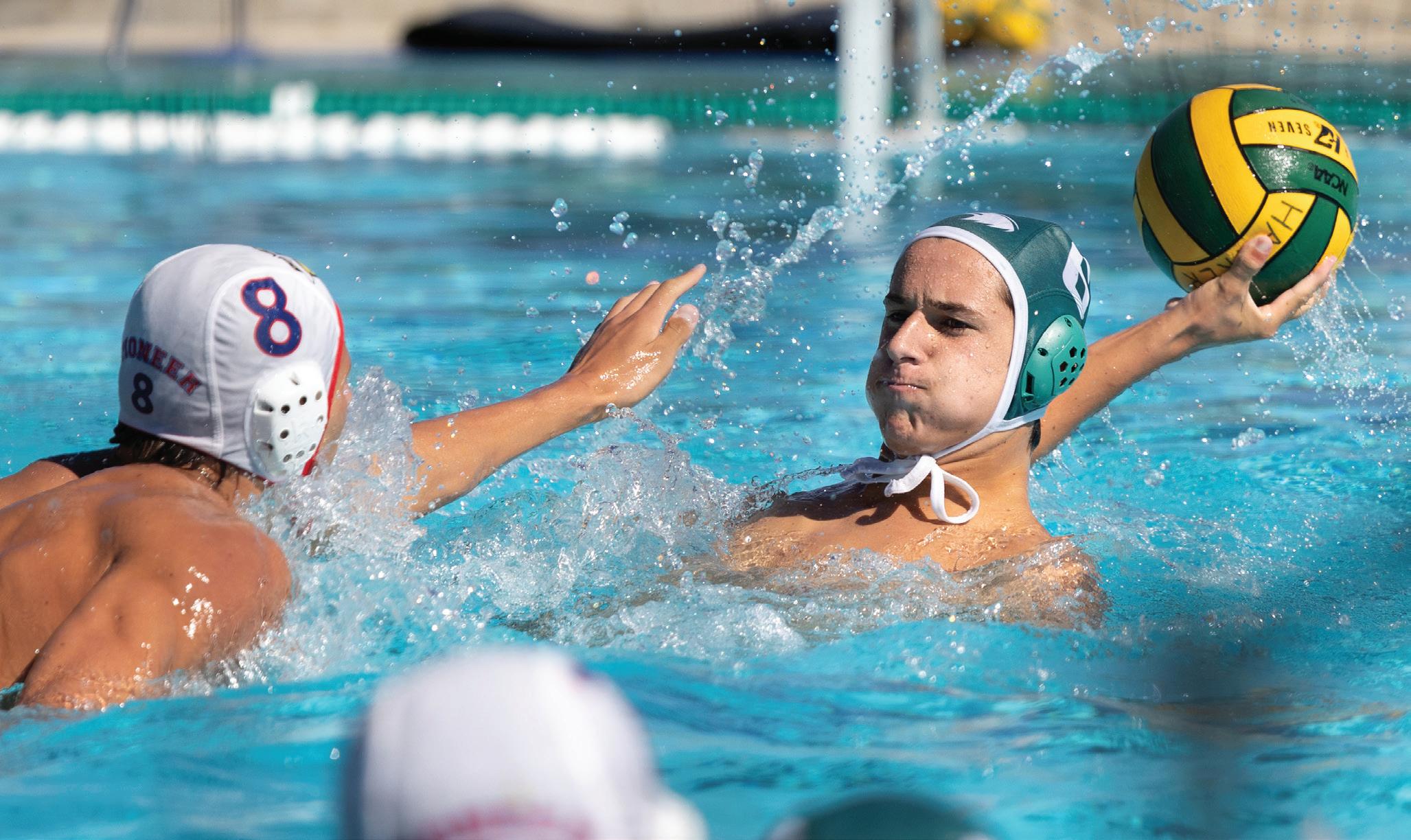
PERIMETER PASS (LEFT)
Varsity girls water polo field player Elaine Xia (11) elevates to flick a pass over a defender. during Harker Day. The team won their game against Cupertino 12-3.
CAREFUL COACHING
(BOTTOM LEFT) Varsity girls water polo coach Victor Adler instructs the team during a timeout against Castilleja. With a 18-3 victory in this game, the team qualified for CCS quarterfinals. WALL ON WATER (BOTTOM)
Varsity boys water polo goalie Alejandro Cheline (12) blocks a ball from entering the goal. Alejandro has the most blocks in both CCS and Harker history with 319 blocks.
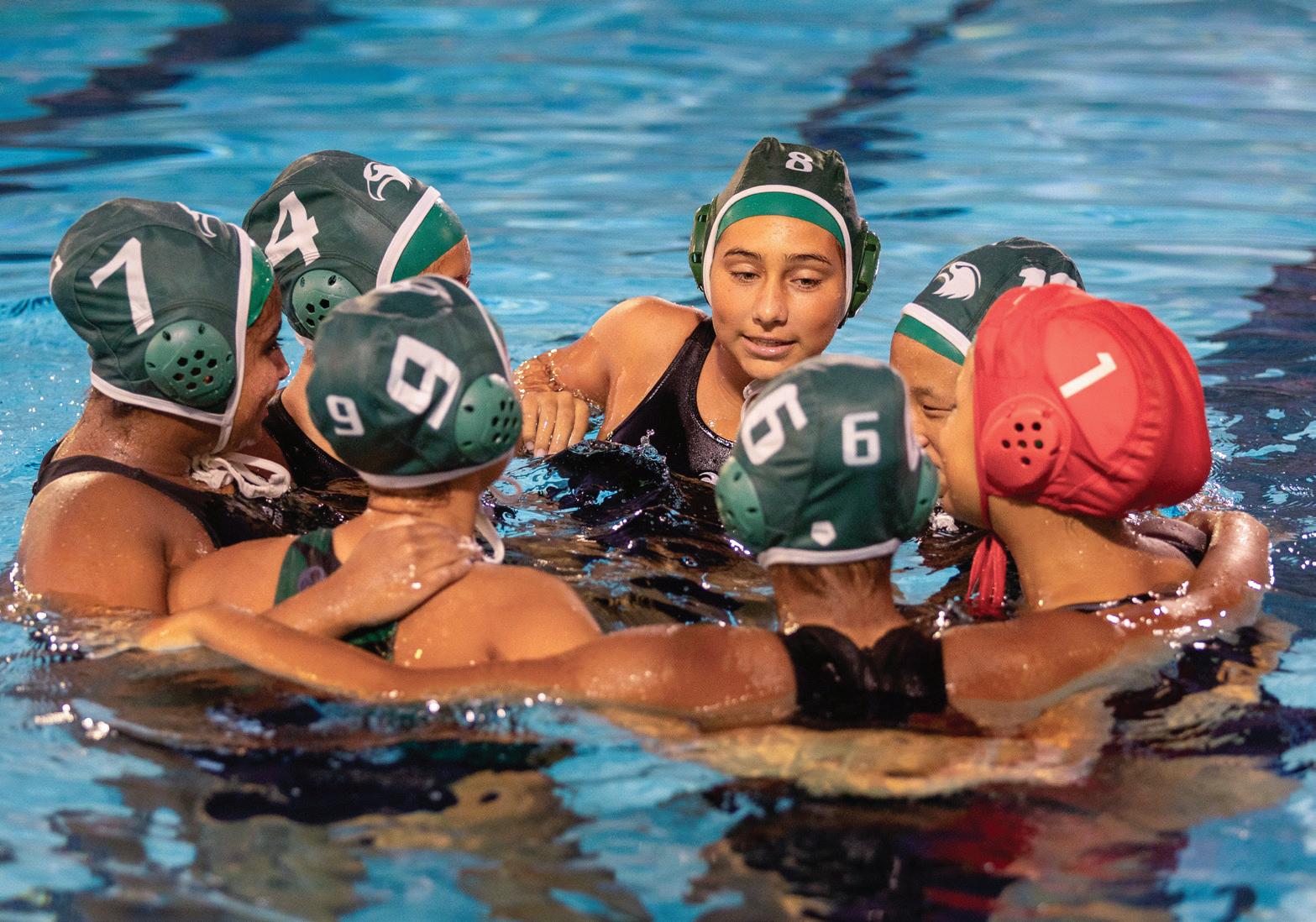
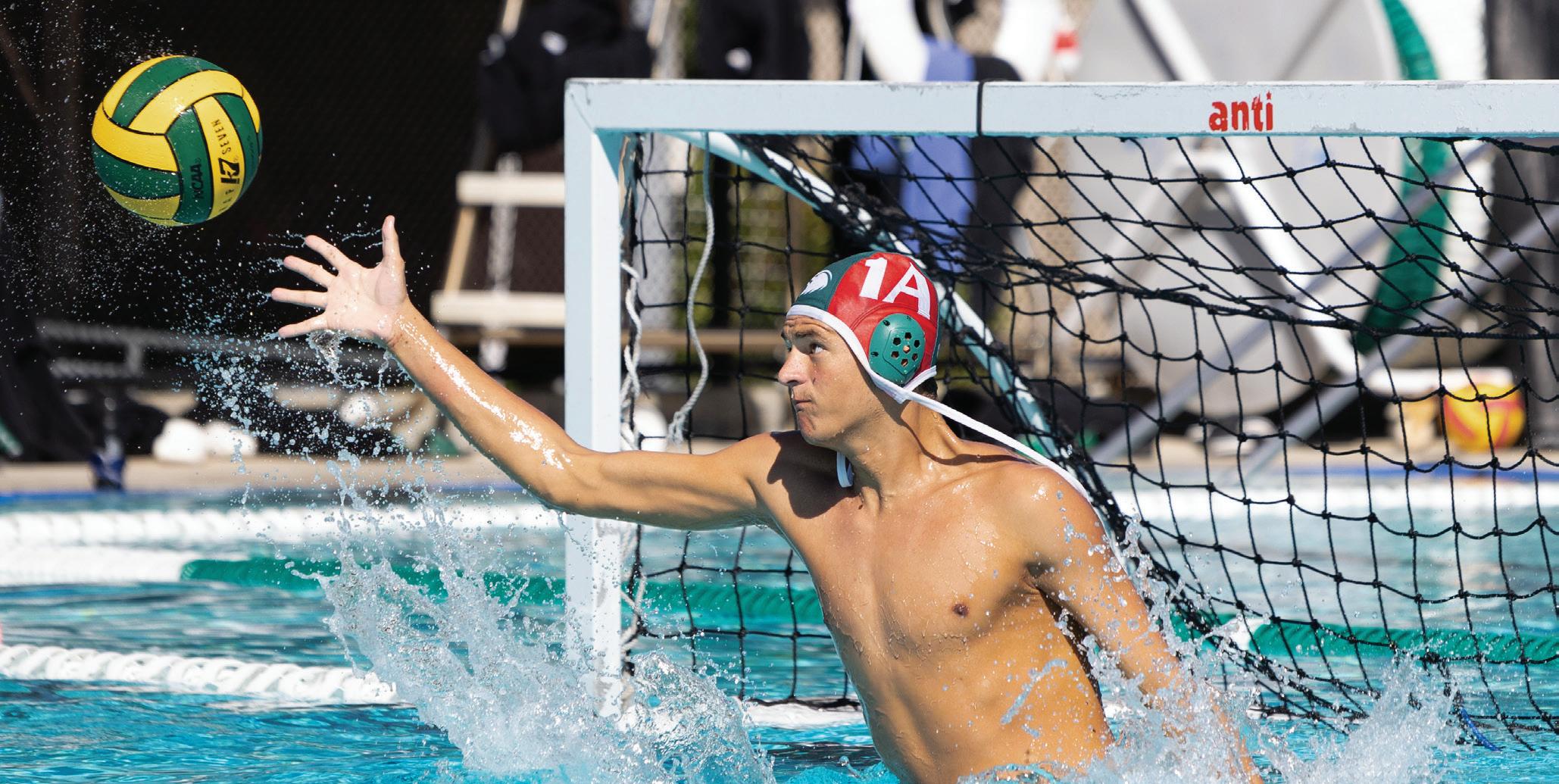

tiffany zhu, kairui sun & dyuthi vallamsetty
Beyond the bustle of student life at the upper school lies dozens of individuals keep our campus running smoothly. From maintenance staff who ensure our facilities remain clean to the Office of Communication connecting us with the broader world, these individuals are the backbone of our daily operations.
As the season of giving thanks approaches, we encourage you to show gratitude to those who work tirelessly behind the scenes. Their contributions often go unacknowledged but remain essential to our school operations. This Thanksgiving, let us pause to recognize and celebrate these members of our Harker community. They are the hands that build and sustain Harker every single day.
Raul Rios manages shipping and deliveries, processing packages from FedEx, UPS, Amazon and freight carriers daily. He sorts and distributes supplies across campus, moving through over 30 cases of paper each week.
“I used to get overwhelmed when I first started, but this is going to be my 25th year,” Rios said. “I’ve learned to separate it into stages. I’ve seen people come and go, but it’s always nice seeing students who come back.”
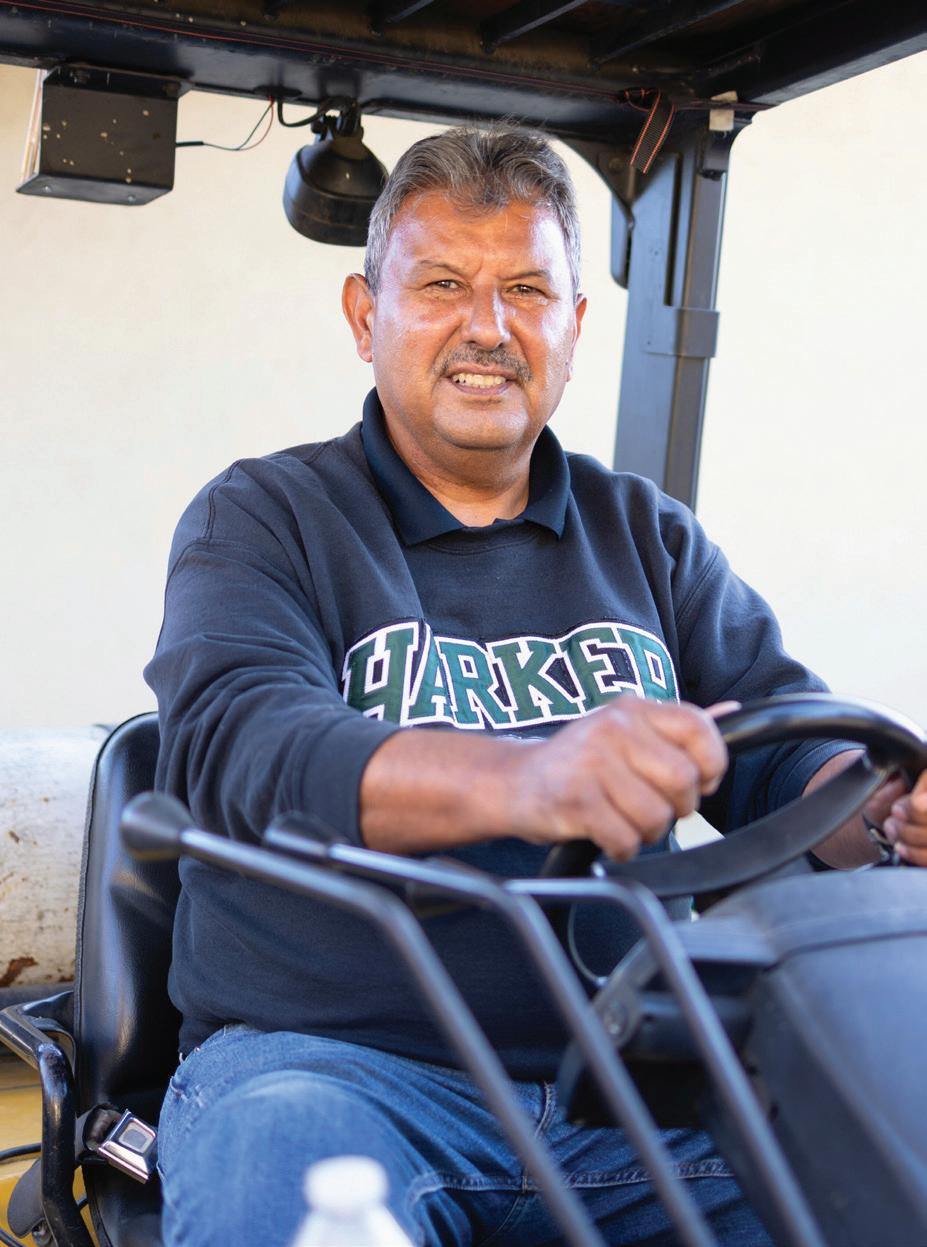
Urdelin Justo arrives at dawn each morning, preparing the campus and clearing leaves and debris before students arrive. He takes the most pride in new landscaping projects that reshape the campus, where his team works closely together,
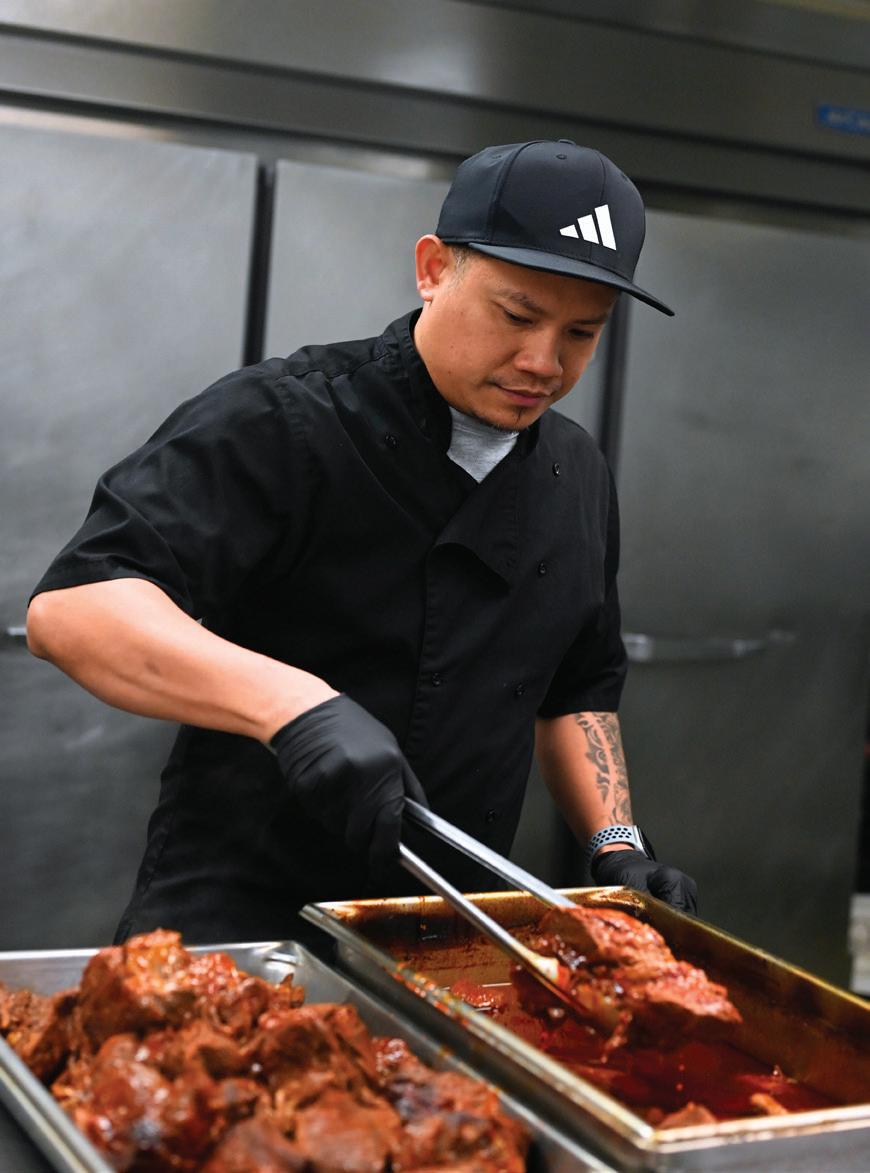
coordinating each step to deliver the best results for the community.
“My favorite part is all of it,” Justo said. “We are like a family here. We do our best to make this place look better. I’ve spent 25 years here, and I want to stay here until I retire.”
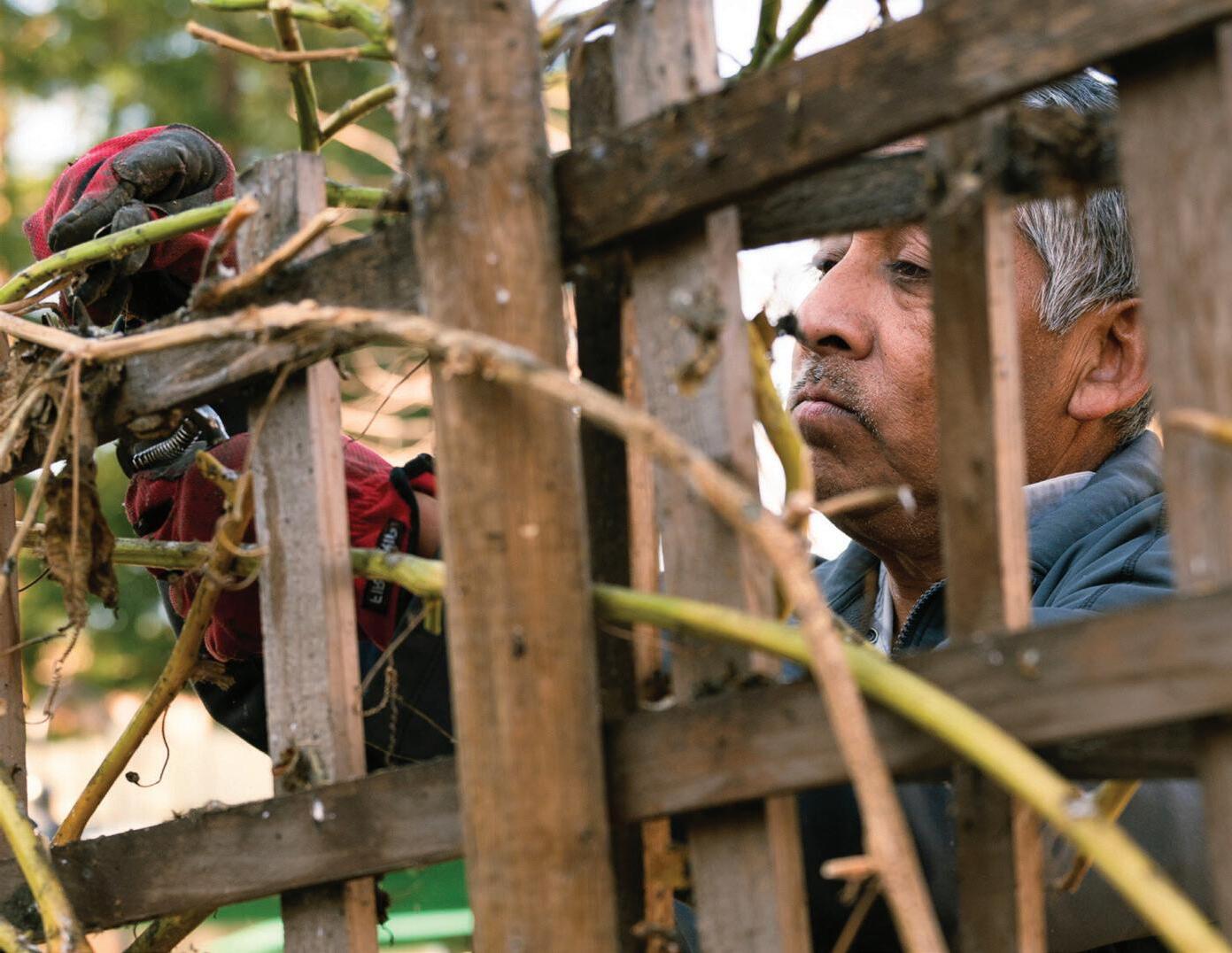
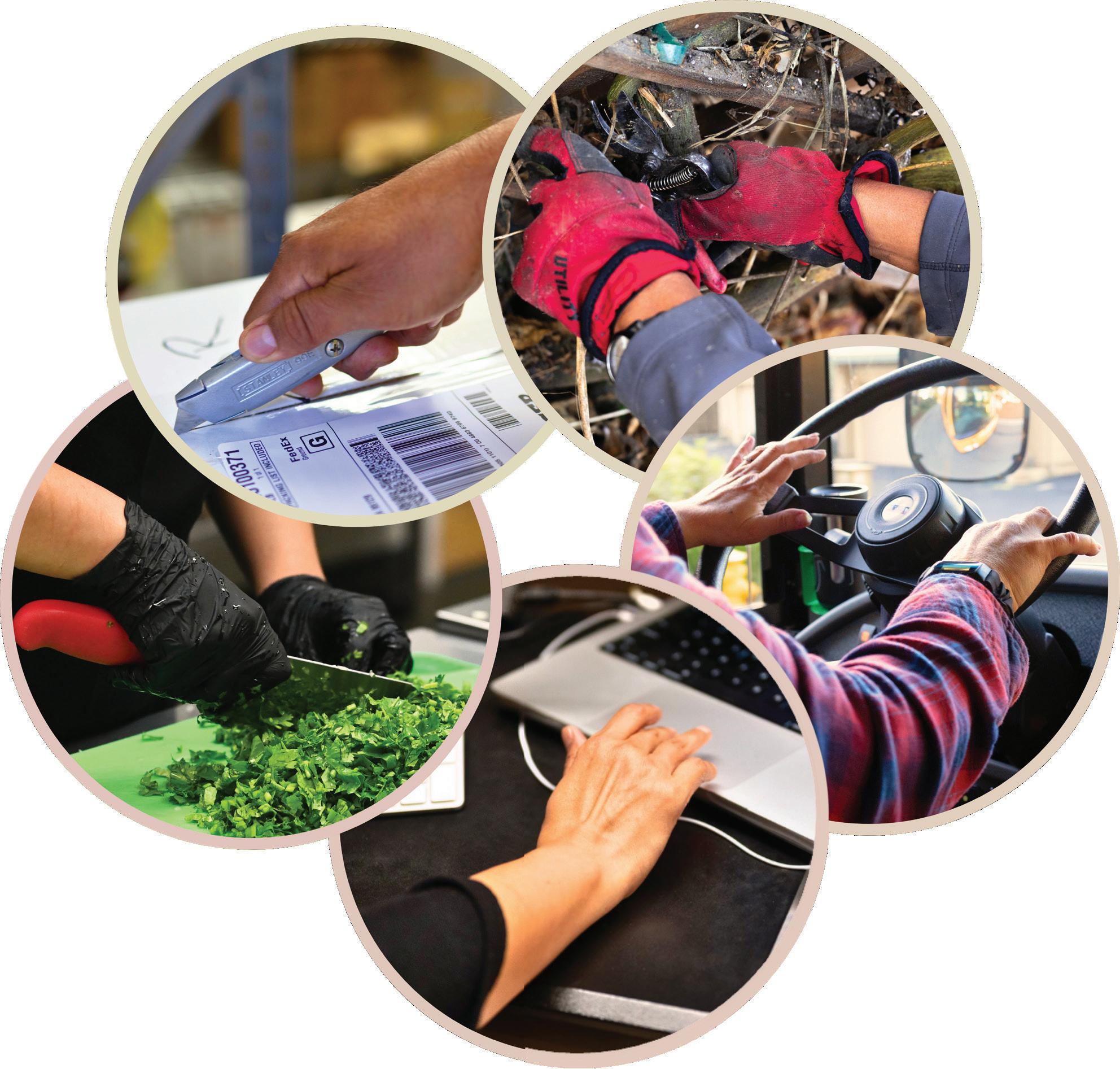
Jimmy Abellanosa works in the Mexican Fiesta kitchen, starting his mornings at 7:30 a.m. making fresh salsa and preparing dishes for lunch service. Since joining the culinary team in 2017, he’s found his place in the school community.
“I love everything about working here,” Abellanosa said. “Last year, I worked at the Boynton kitchen, and now I’m at the upper school, but I always love it no matter where I’m at.”
DELIVERING PACKAGES (TOP LEFT) Shipping and Receiving Associate Raul Rios smiles in the cart he uses to transport packages around campus. OPENING BOXES Rios slices through tape on a delivery he received. MAINTAINING GROUNDS (TOP RIGHT)
Lead Groundskeeper Urdelin Justo maintains the plants around a fence. TRIMMING STEMS Justo prunes a large plant stem. MORNING GREETINGS (BOTTOM RIGHT) Bus driver Charlene Figone laughs during a conversation with a fellow bus driver. STEERING ROUTES Figone steers the wheel on an afternoon bus route. DESK TASKS (BOTTOM CENTER) Attendance Coordinator Rietu A. Raaj smiles at her desk in the front office. CHECKING MAIL Raaj scrolls on her computer mousepad. TRAY TRANSFER (ABOVE) Cook Jimmy Abellanosa moves marinating meat from one tray to another in the Mexican Fiesta kitchen. CHOPPING CILANTRO Cook Yohana Garcia Camacho prepares the cilantro for fresh salsa.
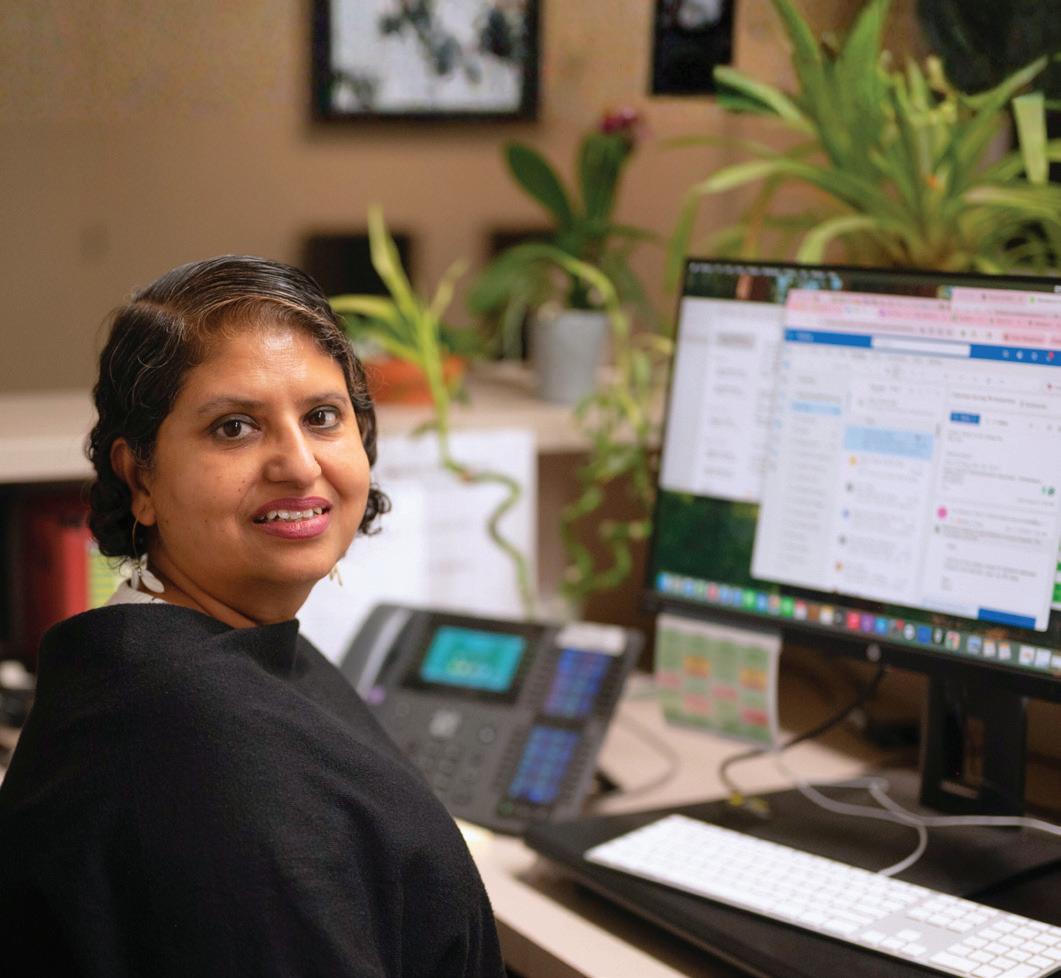

Rietu A. Raaj oversees daily attendance, late arrivals and early dismissals, ensuring every student is accounted for. With a background in child psychology, she approaches each interaction with empathy and care.
“In my communication with students, I try to be more compassionate because I understand when they are going through things,” Raaj said. “When I feel that a student needs extra support, I try to give tools to manage their stress.”
Charlene Figone drives bus routes across multiple campuses and neighborhood stops in the mornings and afternoons. Beyond transportation, she works to create a warm, calming environment on the bus, greeting every student by name and making the ride a place to relax amidst the demands of their daily lives.
“Our job as bus drivers is to make the kids feel safe, comfortable and happy,” Figone said. “We do our best to always make it a safe spot on the bus.”